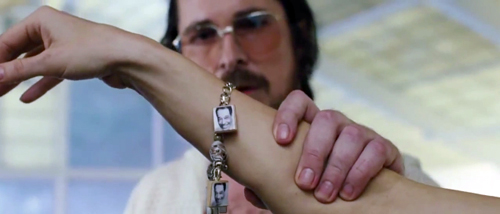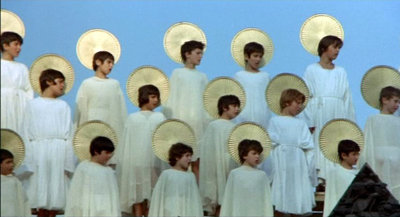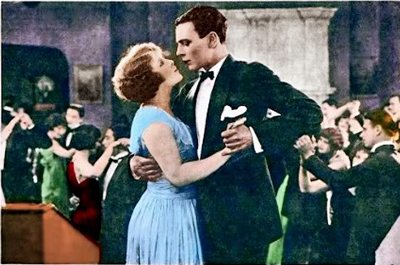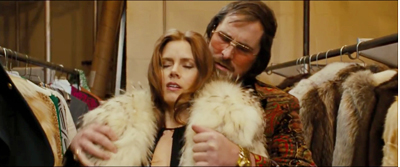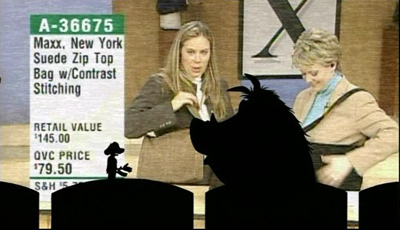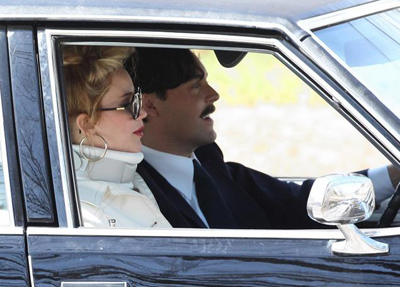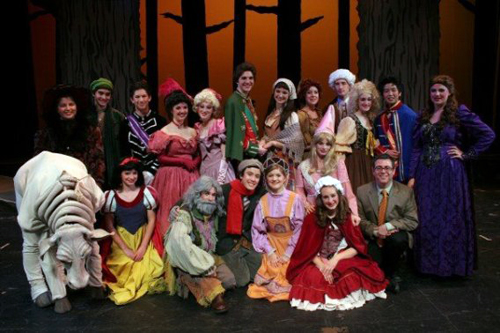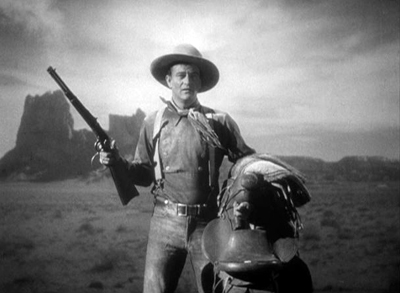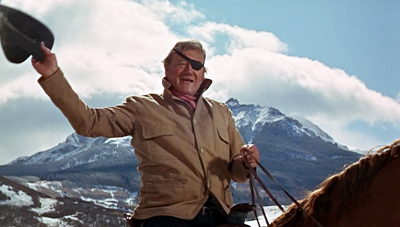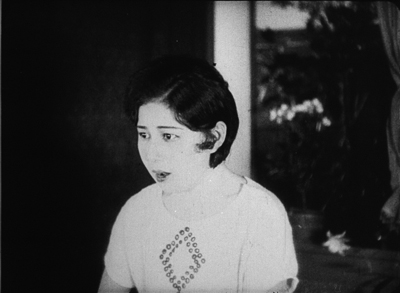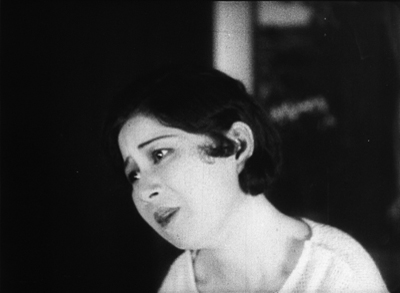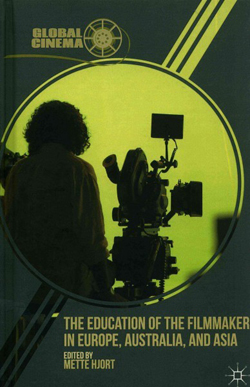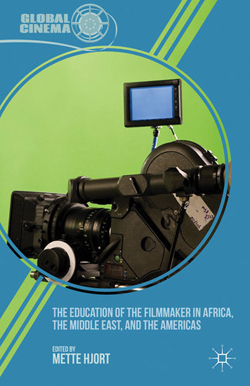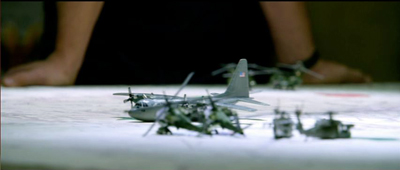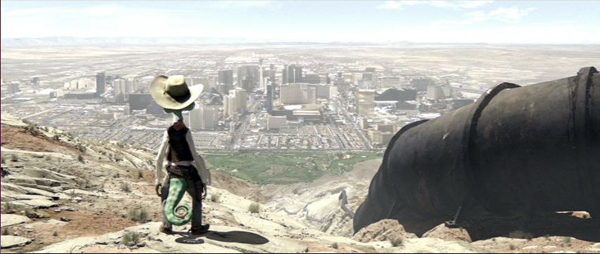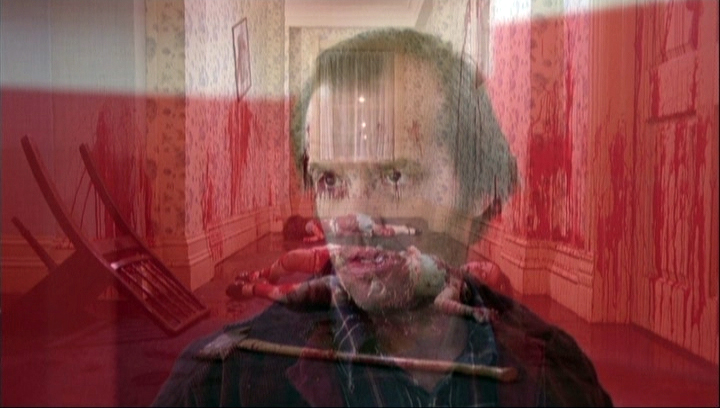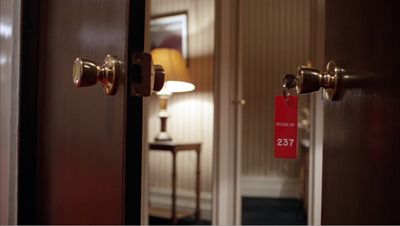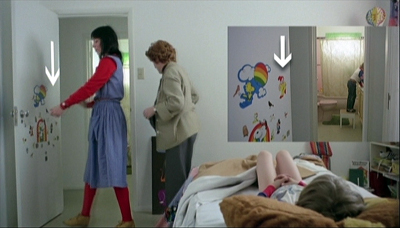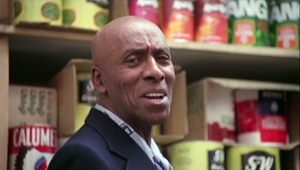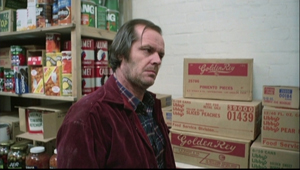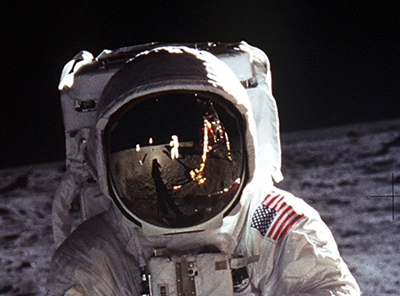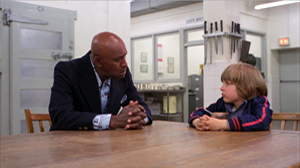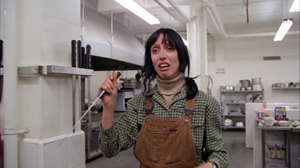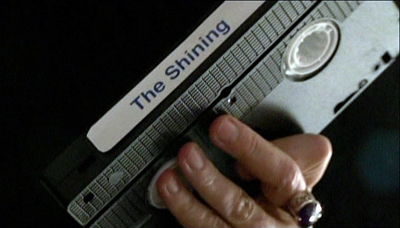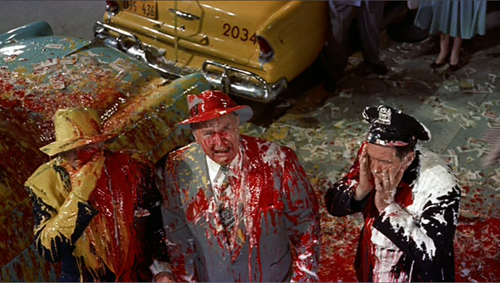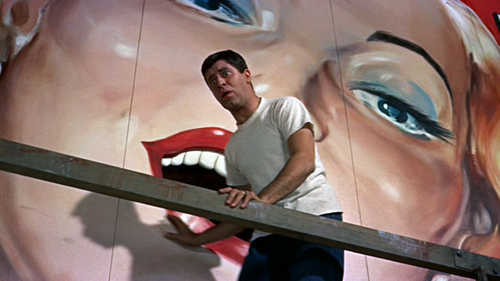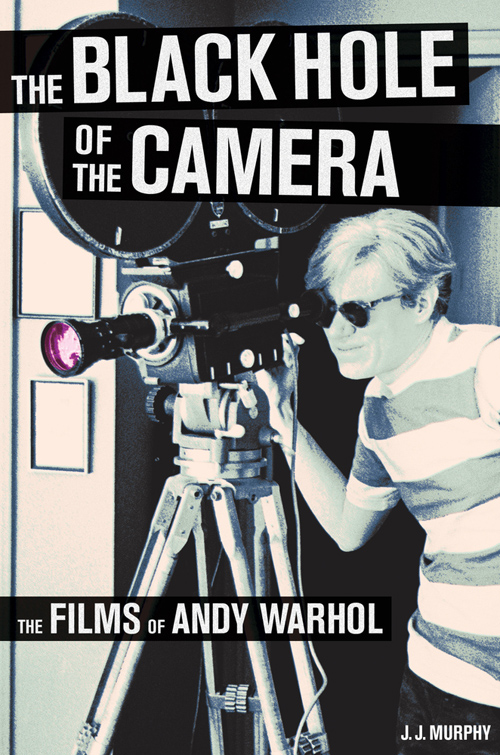Archive for the 'Film theory' Category
Pulverizing plots: Into the woods with Sondheim, Shklovsky, and David O. Russell
American Hustle (2013).
The different writers, who live in different times, come across the same pattern, the same chain of circumstances, which reveal themselves in different ways in each time.
This is how plot travels through time.
Viktor Shkovsky, 1981
DB here:
Besides writing some fine tunes and cunning rhymes, Stephen Sondheim has been an audacious experimenter with storytelling on stage. Do you know Into the Woods? It’s a bittersweet mashup of fairytales. Instead of presenting each one separately, like the vignettes of Japanese history in Pacific Overtures, here Sondheim’s collaborator James Lapine has woven them into one elaborate super-story. Rapunzel turns out to be the sister of the baker who sells bread to Red Riding Hood to take to Grandma. The princes pursuing Cinderella and Rapunzel are brothers who eventually turn their affections to Snow White and Sleeping Beauty. And so on. It’s an ingenious contraption, and I look forward to the film version to be released this year.
Even before that, we can learn something useful from what Sondheim has done. In effect, he has offered us a nifty audiovisual aid for understanding some ideas about storytelling advanced by the Russian Viktor Shklovsky. Shklovsky is surely the most eccentric literary critic of the twentieth century. He is also one of the greatest.
Thanks to Maria Belodubrovskaya and web tsarina Meg Hamel, we’ve just posted the first English translation of a rare Shklovsky essay elsewhere on this site. Today I want to consider a couple of Shklovsky’s many provocative ideas.
All the reverses
Shklovsky wasn’t an ivory-tower aesthete. He fought in World War I, joined the 1917 February Revolution that overthrew the Tsar, and continued an army career. As a Social Revolutionary, he initially opposed the Bolsheviks and spent several years in hiding and in exile in Germany. In 1923 he returned to the USSR and settled in to work as a professional writer.
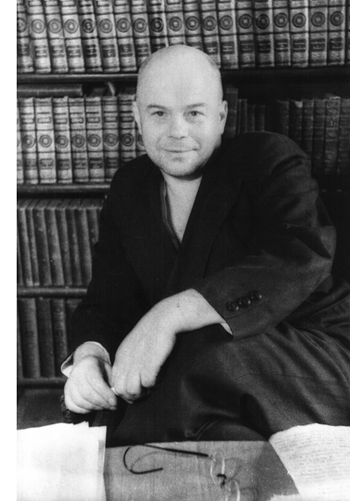 Abandoning university life (he never took his exams), he wrote countless journalistic essays and several film scripts for Soviet classics: By the Law (1926), Bed and Sofa (1927), The House on Trubnaya Square (1928), and the documentary Turksib (1929). His novels were experimental efforts, mixing memoirs with speculations on literature. Zoo, or Letters Not About Love (1923) subverts the form of the epistolary novel by including letters that are not to be read. (A red X crosses them out.)
Abandoning university life (he never took his exams), he wrote countless journalistic essays and several film scripts for Soviet classics: By the Law (1926), Bed and Sofa (1927), The House on Trubnaya Square (1928), and the documentary Turksib (1929). His novels were experimental efforts, mixing memoirs with speculations on literature. Zoo, or Letters Not About Love (1923) subverts the form of the epistolary novel by including letters that are not to be read. (A red X crosses them out.)
He became known for a porous, cryptic approach to writing. He can be repetitious, puzzling, tedious, and maddening; outlining one of his essays is a wrestling match. His jittery style mobilizes brief paragraphs, some consisting of a single short sentence, much as Eisenstein and other directors used short film shots: as a percussive device to assail the reader.
A quick phrase can swing into a digression, a tactic Shklovsky relied on even more as he advanced into his eighties. The man who thought Tristram Shandy was “the most typical novel in literature” had a soft spot for delay and detour. Some variations:
To take a break, I am inserting here a page from one of my old manuscripts.
After such an opening, one can digress in any direction.
Being the theorist of “baring the device,” Shklovsky naturally accentuates the artifice of his technique. “It’s not easy to enact a change of theme,” he says, doing it while talking about it. Later we get a hint of the arbitrariness of organization. “I’ll repeat–continuity can be started from any place.”
Shklovsky’s most enduring fame came through his association with what has become known as Russian Formalism. While studying at St. Petersburg, Shklovsky and some friends formed OPOYAZ, the “Society for the Study of Poetic Language.” They were convinced that the literary history they were being taught failed to get at the essence of “literariness”—the specific quality that made literature a distinct domain. Historians could compile names and dates, speculate on biographical influences and social pressures, but this still wouldn’t distinguish literary forms from non-literary ones. What makes a poem different from a grocery list, a courtroom drama different from a trial transcript?
In the late teens and early twenties, Shklovsky and his colleagues set forth a new approach to literature. That approach was called, by its enemies, “Formalism,” and the name has stuck.
In English, of course, the word has so many meanings that it should probably be retired. Sometimes it means studying “form” and neglecting “content”; that was part of what the Stalinist hacks meant when they insisted that Shklovsky & Co. weren’t advancing the class struggle by emphasizing ideology. Today, to use “formalism” as a slam is often to suggest something similar—that a formalist ignores “content” like race, class, gender, and nation. But the Formalists didn’t neglect content. What others considered content they treated as material that is shaped by the literary work.
Following up Formalist theory fully would take me far afield. Instead, I want to turn to Shklovsky for some thoughts on plot structure that are fairly different from those I floated here a little while ago. Consider it a fuller test drive than my entry from a while back discussing how Shklovskian theory helps us understand the evolution of John le Carré’s career.
Once upon a time
The Formalists were among the founders of “narratology,” the systematic study of storytelling. They gave us the foundational distinction between story and plot, or fabula and syuzhet. The fabula consists of the events in the story world as they’re arranged according to time, space, and causality. The syuzhet consists of the story events as we encounter them in the finished narrative. Flashbacks furnish the most obvious example of how plot structure rearranges story order. Sondheim’s Merrily We Roll Along is more unusual: its plot presents its story episodes in reverse order, so that the last thing we see is the earliest scene in the fabula.
My essay, “Three Dimensions of Film Narrative,” and the accompanying blog post on The Wolf of Wall Street, reflected my basic take on narrative analysis, which is holistic. I try to get a sense of the overall architecture, and see how particular elements slot into that. For instance, by suggesting that The Wolf has a five-part act structure, I traced a development from part to part as Jordan sets up his trading firm, conducts an affair that destroys his marriage, launches an IPO and attracts the attention of the Feds, expands his scheme to offshore money laundering, and eventually comes to ruin….and resurrection. My analysis traced action patterns that unfold like musical melodies through the movie.
Most people would defend a holistic approach in another way. The Wolf of Wall Street runs 173 minutes without credits. Its admirers argue that it needs to be so long because it has to accommodate all the plots and counterplots. True, maybe some scenes are a bit stretched (notably Jordan’s and Donnie’s hilarious Quaalude orgy), but on the whole Scorsese and his screenwriter Terence Winter could say that telling Jordan’s story adequately demanded a long running time.
Shklovsky asks us to think of storytelling less holistically, or at least to think of a different sort of whole. He takes us through the looking glass.
*Instead of treating a narrative as a linear chain of events—say, the adventures of an egoist like Jordan—let’s think of it as a point of intersection of various materials. Not a linear flow, but a collage of items brought in, trimmed, or discarded as needed.
*And instead of taking a narrative as determining the time it takes to unfold, let’s think of the time as determining the narrative. Think of the narrative as built to scale, with a predetermined size into which material has to be fitted.
Every knot was once straight rope
The Decameron (1971).
Shklovsky thinks that a narrative is like a collage because historically, short narratives aren’t cut-down long ones. Instead, long texts have been woven out of short ones. He and his colleagues were much influenced by studies in folklore, which showed that folktales were often built out of familiar pieces, or motifs. A motif might be a character, such as a jealous stepmother; an object, such as a magical ring; or an action, such as a test or competition. Storytellers could combine these motifs to create their plots. This is, on a big and self-conscious scale, what Sondheim has done in Into the Woods.
Shklovsky extends the idea of motif-assembly to the novel, which he claims grew out of collections of shorter stories. One example is The Golden Ass, an ancient Latin novel of the first or second century AD. In this tale a traveler undergoes some adventures but he also encounters characters who tell him their own stories. (Some of those may be based on folktales.) Similarly, the fourteenth-century Decameron of Boccacio consists of tales exchanged among ten characters sequestered to escape a plague in their city.
We have such story-collections in cinema, though they’re not common. Most obviously, Pasolini’s “Trilogy of Life” (The Decameron, The Canterbury Tales, The Arabian Nights) drew upon the tradition that Shklovsky is charting. A Hollywood example would be O. Henry’s Full House (1952).
Finding a pretext for assembling stories exemplifies what OPOYAZ called motivation. Motivation, as I’ve discussed here before, involves creating a justification for a formal choice. Motivation isn’t just for actors who figure out why a character behaves a certain way. It’s for every artist, as when a cinematographer tells of needing to “motivate” a pattern of light by providing a lamp or window.
More broadly, motivation gives the audience a reason to accept a formal option. One of my favorite examples comes in Citizen Kane. Having decided to tell Kane’s story in flashbacks more or less chronologically, Herman Mankiewicz and Orson Welles confronted a problem in their frame story. After Kane’s death a reporter would naturally turn to his surviving second wife before contacting friends or associates. But if Susan recounted her memories of Kane before the other witnesses did, her episodes would come from late in his life and throw off the chronology. Therefore the script makes Susan too drunk and angry to talk to the reporter Thompson when he calls. He must proceed to the Thatcher library, where he’ll learn about Kane’s earliest years. Later, when Susan is more sober, she recounts her flashback in its proper, chronological place.
Motivation is everywhere in cinema, and it assumes different guises. Sometimes filmmakers motivate their choices by realism. Susan, being an alcoholic, might well angrily refuse to talk to the reporter. Filmmakers also appeal to genre-driven factors, as when people sing and dance in a musical; presumably this will be the rationale for the musical numbers in the movie of Into the Woods, as they are in the play. Very often the motivation springs from what the plot demands. In a mystery, to keep viewers in the dark, you can attach the action to an investigator who gradually discovers what’s really going on.
Sometimes style needs motivation. In the recent vogue for first-person films like End of Watch, Chronicle, and the Paranormal Activity series, the makers find excuses for the characters to use their video cameras to record what’s happening.
Foreshadowing is a sort of motivation too. In The Wolf of Wall Street, Naomi’s aunt Emma comes to the couple’s wedding. In realistic terms, inviting a relative to the ceremony is plausible, but it’s there for structural reasons. The plot needs to introduce a character living overseas whom Jordan can later use to hold his smuggled money. This might seem a cold-hearted way to view a character, but the plot treats her just as heartlessly, killing her off at just the moment that precipitates a climax.
In sum, Shklovsky’s engineering approach prods us to ask why something is in this tale—not according to character psychology or thematic statement, but as part of a system of materials and their motivations. Perhaps Shklovsky thought he could motivate his late-period digressions by the reader’s knowledge of his age: the Grandpa Simpson alibi.
I’m in the wrong story
Wine of Youth (1924) publicity still.
How to motivate the sort of story-collections we started with? Minimally, you can create a framing situation in which one or more persons share a tale with an audience; that’s the Decameron solution. You can go further by making the tales seem to belong together. Perhaps they parallel one another, either explicitly or implicitly. One might prove that crime doesn’t pay, while another disproves it. Shklovsky calls this “a debate of stories.” In the 1924 film Wine of Youth, a young woman hears from her mother and grandmother about their courtships. The similarities and differences across the generations create comic parallels to the young woman’s own romance.
You could also motivate the connection between the frame story and the embedded ones. Shklovsky mentions that the very act of telling can slow down the action in the frame story, as when Scheherazade keeps narrating every night to postpone her death. Or perhaps a discovered manuscript (the embedded story) will have an impact on the people finding it. You might try to somehow blend the told story with the act of storytelling. In the British film Dead of Night (1945) the separate stories all involve fantastic events, and the people telling the tales stand outside them. But the film’s climax seems to turn the frame story itself into such a fantasy, creating a sort of Mobius strip that twists the film back to its beginning.
I think, though, the greatest power of Shklovsky’s idea comes with the notion that any big narrative is really composed of smaller ones. He goes beyond episodic assemblies like The Decameron and Dead of Night to suggest that even the most “organic” or tightly-designed plots can be considered well-disguised story collections. In other words, my holistic assumption is countered by one that treats a well-shaped whole as a heavily motivated collage of different stories. From Shklovsky’s perspective every narrative of any complexity is like Into the Woods.
We can imagine a continuum of the ways in which fairly distinct story lines are woven into one big one. You might bring the characters together in a single space, such as an inn. Cervantes used this tactic in Don Quixote, and the great Chinese filmmaker King Hu revived it in several of his films. Grand Hotel, Hotel Berlin, The VIPs, Nashville, and many other ensemble films gather different story lines within a single space and let them intertwine. Sondheim and Lapine brought their fairy-tale plots together in the same locale, the primeval woods. Often the linkage is one of time as well, with the action compressed into a few hours or days.
Given a unity of time and locale, we expect that the story lines will affect one another, which indeed happens in the films I’ve mentioned. This puts us in the land of what I’ve called “network narratives” and what Peter Parshall studies in his book Altman and After.
Apart from spatial connections and concentrated time connections, you can hook up your source-stories more tightly. Most complex narratives assign the characters roles in different story lines. For instance, Into the Woods ties its fairy-tale figures together by friendship, acquaintance, love, and kinship. Characters create goals that involve other characters. Rapunzel’s mother the witch demands ingredients for a potion, and these bring in Red Riding Hood, Jack and the Beanstalk, and Cinderella.
The implication is that every plot of any complexity, no matter how smoothly all its parts seem to fit together, is a paste-up, a virtual recombination of simpler action lines sewn together by motivations. A romantic comedy with a main couple and a secondary one? It’s essentially two separate plots joined by the simple strategy of making the couples friends with each other. The detective story in which various characters tell us their alibis? Separate plots hooked up by the need to involve them in the murder investigation. The heist movie that follows all the characters partnering in a single robbery? It compiles plots about different thieves and welds them together by a shared knockover.
Any path . . . so many worth exploring
For Shklovsky, even a novel’s protagonist can serve as a motivating device for connecting the various stories he or she encounters. “Gil Blas is not a human being at all. He is a thread, a tedious thread, by means of which all the episodes of the novel are woven together.” Likewise, in The Wolf of Wall Street, Jordan is not given a lot of depth. Some viewers have criticized this tactic, since he doesn’t change his attitude or ethical outlook, and seems to learn nothing from his rise and fall. Shklovsky could suggest that he’s chiefly a device for hooking together a string of episodes about the giddy high life of stock trading. Showing a weasel behaving like a weasel for three hours—some viewers have found him indeed “a tedious thread”—isn’t especially edifying in itself, but the film’s fascination comes chiefly from the escalation of excess we’re invited to witness.
From this angle, The Wolf of Wall Street somewhat resembles another current release, The Great Beauty. This film is more explicit in using the protagonist to combine plots that represent a cross-section of a society. We’ve had other films that use one character to survey, fresco-fashion, different milieus. Mizoguchi’s Life of Oharu is one such plot, and La Dolce Vita, to which The Great Beauty has often been compared, is another. Usually, though, the protagonist responds to what she or he encounters and changes as a result; in The Great Beauty Jep’s wanderings create a sort of ephiphany. Perhaps the novelty of the plot of The Wolf of Wall Street is that after being introduced to high-flying hedonism Jordan rushes in and never looks back.
Of course we could imagine other versions of The Wolf—an apprentice plot showing us Jordan learning the ropes at length from Mark Hanna, or a multiple-protagonist plot in which Donnie, Teresa, Naomi, and other characters get much more attention. Shklovsky reminds us of what screenwriters know instinctively: plot unity is often a matter of ruthlessly chopping out all those intriguing alternatives. Every complex tale is yanked and snipped out of a vast network of potential plots.
Consider American Hustle, much more of an ensemble piece than The Wolf. (Spoilers ahead.) I see it as a romantic comedy with a crime ingredient. Three principal love triangles are interlocked (Irving-Sydney-Rosalyn, Irving-Sidney-Richie, Irving-Rosalyn-Pete). These are pushed forward thanks to the doubled plotline characteristic of classical Hollywood cinema: work and love so intertwine so that the sting operation develops along with the romantic complications. David O. Russell and co-screenwriter Eric Warren Singer use many well-practiced comic conventions, including overheard conversations that precipitate crises. (As usual, no coincidence, no story.) In its unfolding American Hustle fits Kristin’s four-part-plus-epilogue model tidily.
In contrast to my perspective, Shklovsky invites us to consider how several conventional plots are squeezed into Russell’s film. Here are some.
*A husband has an affair with another woman, and his wife learns of it.
*A woman is a man’s mistress but another man is attracted to her. She leads both of them on.
*A con artist fleeces gullible people with the aid of a confederate.
*A dutiful father tries to protect his son from the mother, who’s a little crazy.
*A man betrays his friend and feels the need to confess it, even though it will ruin their friendship.
*A cop tries to bring down big-time crooks, against the wishes of his supervisor.
*A cop has captured a crook and wants to use that crook to get to higher-ups.
*A wife, feeling ignored by her husband, seeks the attention of other men.
*A man has a fiancée approved by his mother, but he’s attracted to a more glamorous woman.
*A small-time crook tries to scam the Mafia, and the gangsters learn of it.
*A father warns his sons against fishing on thin ice.
These plots are blended by having a few characters play multiple roles in them. Even in this profusion, by rewriting the film we could go further—say, expanding the conflict between the cop Richie and his mother, or going back further into Sydney’s past. As with The Wolf, by developing the sub-stories, we could multiply story threads forever.
Narrative can flourish like kudzu. What curtails things? Among other things, the second factor I mentioned at the outset: format.
Slotted spoons don’t hold much soup
Shklovsky suggests that very often a story is created (or re-created) in order to be of a certain size. Instead of the old saw “form follows function,” Shkovsky suggests another: form follows format. The length of the narrative is dictated in large part by the sort of thing it’s going to be. A pop song isn’t an operetta, a short story isn’t a novel, a miniature isn’t a mural.
At first glance this notion seems too stringent. Surely a poem or play can be any length we want. There are gigantic symphonies and sprawling picture scrolls. Whitman seems to have had no problem adding more and more poetry to editions of Leaves of Grass. But these instances might be exceptional.
There will always be outliers, especially among the avant-garde, but most storytellers work in media that set limits and favor certain lengths. At the moment, three hours is sort of a maximum for a Broadway musical play like Wicked, The Book of Mormon, or Spider-Man: Turn Off the Dark. It makes sense that, given high ticket prices, audiences want a reasonably extended experience. They get one in Into the Woods: it standardly runs about three hours, including intermission.
Even a big name like Sondheim works within time constraints. When he and James Lapine were contemplating redoing a fairy tale, they made a discovery.
Fairy tales, by nature, are short; the plots turn on a dime, there are few characters and even fewer complications. This problem is best demonstrated by every fairy-tale movie and TV show since Snow White and the Seven Dwarfs, all of which pad the lean stories with songs and side-kicks and subplots, some of which are more involving than the interrupted story itself. And those are all less than two hours long.
They needed to expand their material to Broadway length, and they did it by recalling an idea they’d concocted long before—a TV show that brought together characters from other TV shows.
Shklovsky’s suggestion is particularly attractive to those of us who study media because most artworks in commercial formats fit basic dictates of size. . US network TV episodes run 22 minutes or 45 minutes. Novels have roomier boundaries, but editors still have their preferences. According to a publisher’s marketer, in 2010 the ideal novel ran between 80,000 and 110,000 words. The doorstops bestowed on us by Rowling, Martin, and Stephen King are the market-tested, lucrative exceptions.
As for films, we still have pretty strong constraints outside avant-garde and festival pieces like Sátántangó (seven hours). A-level feature films in the 1940s typically ran between 80 and 120 minutes; B-films were typically 60 to 80 minutes. The longest running times were reserved for roadshow specials like Gone with the Wind and Duel in the Sun. I don’t know of a systematic study of changes in running times, but today there’s still apparently a two-tiered system. Program pictures (horror, action, raunchy comedy) with unknowns or minor stars (e.g., Jason Statham) can run around 85-100 minutes, with credits. The big releases can run two hours or more, but seldom more than three. When asked why originally The Grandmaster was 130 minutes, Wong Kar-wai is said to have replied, “All movies are 130 minutes now.”
Granted, directors’ cuts and alternative editions offer some flexibility. An initial four-hour cut of The Wolf of Wall Street had to be chopped down to a little less than three, but the long version may show up on disc or VOD. For all I know, it could become a mini-series. But even then its installments will be constrained by the running times of that format. And my other main example today, American Hustle, fits Wong’s point: Without credits, it runs 130:30.
Only three more tries
Lion King 1 1/2 (2004).
How is the format’s scale connected to Shklovsky’s idea about building your narrative out of pieces? This way: You find or create the pieces that will fill out the narrative to a conventional size. The format helps you decide how much to add or take away from the ongoing collage you’re creating of characters, actions, and story lines. Again it’s a matter of motivation, finding ways of justifying what you want to keep in or leave out.
Within the overall size of the piece, there are smaller chunks that need to be filled. A recent example is Anchorman 2.5, in which new gags replace old ones but still must be squeezed into the original scenes. Today’s screenwriting manuals, with their insistence on something big happening on certain pages, also indicate how storytellers are encouraged to invent material to be fitted into a fixed frame. Some people hate the idea of a “formulaic” screenplay, but Shklovsky the pragmatist would, I think, compare it to verse forms like the sonnet and the haiku, which dictate quite specific slots to be filled. In this respect, Kristin’s multi-part model of mainstream feature films is compatible with Shklovsky’s idea: She has made the format’s customary subdivisions explicit.
Very often, you may need to stretch out a story situation to fit the time allotted. To some extent, folding several mini-plots into your big plot gives you the chance to extend the whole thing. In particular, often the plots don’t blend but actually block one another. In American Hustle, Rosalyn’s jealous-wife storyline serves to prolong the action around Irving and Richie’s scam, especially when she starts flirting with the casino magnates at the big dinner. Similarly, Richie’s escalating schemes to go after bigger crooks keeps thwarting Irving’s plan to mount simple scams that will let him and Sydney skate.
What to do when you lack material? We have some historical examples. In cinema, Griffith found several ways to fill out the one- and two-reel formats. Instead of simply showing characters coming into a scene, he filmed simple, mostly undramatic “goings and comings” that followed characters leaving one spot, traveling, and arriving at another spot. He also discovered that he could stretch out a situation by crosscutting two simultaneous actions.
An Aristotelian could say that Griffith discovered that crosscutting could generate suspense in rescue situations, but Shklovsky starts from sheer delay as an engineering principle. Why do the villains in such situations take such an ungodly time to accomplish their villainy? In 1923, Shklovsky recognized the emerging conventions of action cinema, still going strong today.
Attempted rape in a modern film is almost canonized. The victim is struggling, her friends are far away, the villain is pursuing the woman, “meanwhile,” etc. In my opinion, the choice of the crime in this instance is explained not so much by the desire to play on the spectator’s interest in eroticism as by the actual nature of the crime, which requires for its completion a certain amount of time. Instead of rape, take murder by pistol shot. Such an act is too indivisible. That is why cinematic villainy is usually perpetrated by a method that requires a large amount of time—drowning, for example, with the victim suspended upside down in a cellar and water pouring in. Sometimes the victim is bound hand and foot, then tossed on the railroad tracks, or else immured. Also effective is abduction in all its varieties. Only minor characters, not involved in the plot, are killed off immediately.
He might have added that the hero may be given a weak friend, whose death can be a little more protracted (and motivate the hero’s quest for revenge).
We tend to think of delay as padding, but actually narratives need it. Delay can be unmotivated, as digressions are. More often it’s motivated. In folk tales, why does the hero have two brothers? So that they can try and fail at the task that he will accomplish. (Hollywood’s rule of three may have its roots in folklore.) Stretching out the intervals between major plot points allows other things to be inserted—gags, character exposition, musical numbers, witty dialogue. Tarantino is very accomplished at dialogue-driven retardation. Call it the Royale-with-Cheese tactic.
It sounds strange to think of a novel’s descriptions of what characters eat and wear and drive as filler material. Ditto weather reports and portraits of neighborhoods. But Shklovsky suggests that in most cases that’s what these portions are, more or less motivated bits that flesh out the plot and connect the bits that the story-maker has brought on for this occasion. They can be further elaborated to create motifs and bind the work more firmly.
It seems even stranger that the same purposes of filling out the format and delaying the main events should be fulfilled by character traits. We tend to think of characters as modeled on living people—simpler, but with recognizable traits, habits, temperaments, and the like. For Shklovsky, a character can be minimal or maximal, depending on how much time or pages you have to fill. If your plot material is thin, you can thicken it by expanding your character, and at some point you have a psychological novel.
In some cases, by searching for material to expand the tale, the artist discovers new depths in his characters, as Shklovsky thinks Cervantes did with Don Quixote. The Don, initially a compilation of clichés drawn from chivalric romances, becomes richer as the first book proceeds. By the second book there’s a new self-consciousness about Quixote and Sancho, who are now famous to the other characters as heroes of the first book. You might think of The Godfather Part II or the sequels to Back to the Future when Shklovsky notes that the sequels to novels often change their structure radically, taking the original as a pretext for other explorations. The ill-remembered Book of Shadows: Blair Witch 2 (2000) and the more ingratiating Lion King 1 ½ (2004) use the Quixote device of building a sequel around characters who know the first installment.
Similarly, characterization serves to freshen up the familiar plot ingredients in American Hustle. Irving isn’t a slick con artist but rather a passable klutz who needs the social grace injected by Sydney. Richie isn’t your usual cop on a mission but a working-class guy burning with ambition, and this leads him to expand the scam to a level he can’t handle. Rosalyn is the slightly batty wife who’s expert in passive-aggressive combat. I suspect that what a lot of audiences enjoy about the film is the way several conventional characters are given vigorous detailing by the writing and the performances.
Happy ever after
The act of combining and fitting stories to a format demands that the storyteller find an ending. Shklovsky doesn’t have a lot of respect for endings. Given that making and motivating a plot are fairly arbitrary, the wrapup is likely to seem even more so. Shklovsky says that Thackeray wished he could order his servants to compose the endings of his novels.
Part of the problem is that while beginnings and middles bristle with surprises, resolutions are fairly routine. There’s the tragic ending, in which the hero dies. Another option is the ABA pattern, or “Here we go again.” In The Wolf of Wall Street, Jordan starts over, selling not stocks but the very idea of selling. Something similar seems to happen at the close of Into the Woods. The main action springs from people yearning for more than they have, given in the opening number, “I Wish.” After all the mishaps and deaths, the characters seem to settle for what happiness they have. Hence the bustling closing number, “Into the woods…and happy ever after.” But just as that song resolves and closure seems complete, Cinderella pipes up with “I wish….” Here we go again.
Then there is what Shklovsky calls the “incomplete” ending, the sort of open structure that doesn’t fully tell us how things work out. Chekhov and Maupassant are Shklovsky’s examples. In such instances, he points out, our cue for conclusion is often a description of the setting or the weather. In a way, these inconclusive endings acknowledge a fact of art: all endings are equally conventional, pieces of high artifice. None captures real life, which is absolutely endless in a way a text can’t be. Individuals die, but human life continues, and fate is essentially indefinite.
Shklovsky realizes, however, that readers favor the happy ending. Lovers are united, usually by marriage, or the adventurer returns safely from peril (the end of Jaws). American Hustle, being at bottom a romantic comedy, concludes with the main couple back together and successful in their art business. There’s also the formation of a secondary couple, Rosalyn and the mobster Pete. The pay-to-play mayor, who wants genuinely to help his city, gets mildly punished, while the real loser is the cop Richie. He becomes the expelled lover in the Ralph Bellamy tradition.
I think that Shklovsky would enjoy the film’s self-consciousness about its neat wrapup. American Hustle parodies the model of the incomplete ending. We never learn the outcome, or the point, of Stoddard’s childhood memory of ice-fishing. And the film’s final line, heard in Irving’s voice-over, ties his forged-painting scam to the overall dynamics of the plot: “The art of survival is a story that never ends.”
By tracing the activity of linking materials and filling the format, Shklovsky isn’t, I think, trying to describe every storyteller’s creative process. Many writers simply pour the stuff out. What I think he’s proposing are the principles behind the process. A practiced writer does all this intuitively. I once asked Elmore Leonard if he planned the very long dialogue scene that runs for several chapters in Get Shorty. He said, “It just came out that way.” But I notice that without that long section, the book would be severely out of balance—and too short. It’s a virtuoso cadenza, at once pure retardation and a package of motifs that point both forward and backward in the plot.
We’re now quite at home with films that intertwine storylines, restart storylines (Groundhog Day, The Butterfly Effect, Source Code), present branching and forking-path storylines (Run Lola Run, The Girl Who Leaped through Time), or simply set barely connected stories side by side (Chungking Express, Flirt, Nine Lives). So we should be ready to see more traditional plots as heavily camouflaged attempts at combining smaller stories. We should likewise be ready to see how stronger or lesser motivation governs all the options. Source Code relies on a science-fiction premise and a thriller deadline, while Groundhog Day motivates its replays and variations by setting its action on the one day that posits that the future will turn out either this way or that way.
For my part, I confess myself both an Aristotelian and a Shklovskian. I think that we ought to look for a plot’s structural unity at many levels. I think as well that those levels may incorporate the most wayward materials. The pieces are pulled into place and held there, sometimes precariously, by the scale of the format, their local purposes, and the motivational pressure of other components. Vincent Vega’s Royale-with-cheese exposition does hook up with the Big Cahuna burger we encounter later.
And both approaches provide useful critical tools. Seeing Jordan as a pretext for a dissection of his Wall Street world opens up certain aspects of the film that might not be apparent if we kept expecting him to follow a learning curve. By seeing how American Hustle braids together many standard plot patterns, we can explain how the film can juggle its situations with such speed and how we can look forward to seeing certain patterns fulfilled (or not). Studying narrative from either a holistic or a “montage” perspective can only enhance our appreciation of all the different kinds of stories we encounter.
To save you scrolling back up, here is another link to Shklovsky’s “Monument to a Scientific Error,” posted in the Essays section of this site.
This entry’s primary accounts of Shklovsky’s thinking on narrative are drawn from his essays “The Structure of Fiction” of 1925 and “The Making of Don Quixote” of 1921. Both are included in his landmark book Theory of Prose, originally published in 1925 and available in translation from the ever-vigilant Dalkey Archive. Shklovsky talks about the distinction between form and material in the early chapters of the 1923 book Literature and Cinematography, trans. Irene Masinovsky (Champaign: Dalkey Archive, 2008); my quotation about villainy is drawn from p. 60. Other references are from the 1981 Energy of Delusion: A Book on Plot, trans. Shushan Avagyan (Champaign: Dalkey Archive, 2007).
French Structuralism borrowed considerably from the OPOYAZ school. Roland Barthes launched his own version of Shklovsky’s retardation thesis in both his “Structural Analysis of Narratives” essay (the distinction between kernel actions and satellites) and his S/Z (the distinction between the proairetic code and the semic code). For his part, Shklovsky was skeptical about Structuralism, not least because of its vocabulary. “People today get carried away with terminology; there are so many terms that it’s impossible to learn them all, even if you’re a young person on vacation” (Energy of Delusion, 177).
My quotation from Sondheim about the construction of Into the Woods comes from Look, I Made a Hat: Collected Lyrics (1981-2011) with Attendant Comments, Amplifications, Dogmas, Harangues, Digressions, Anecdotes and Miscellany (Knopf, 2011), p. 57.
For more on how the split-roads motif of folklore persists in modern storytelling, see this earlier entry. I consider how embedded stories and framing situations can tax our memories in this entry. The multiple-drafts plot of Source Code is considered here, while various motivations for first-person video style are explored in these pieces on Cloverfield and the Paranormal Activity cycle.
Into the Woods cast, San Mateo High School production of May 2006.
The book stops here: Theory, practice, and in between
Tinpis Run (Pengau Nengo, 1991).
DB here:
Apart from things I’m reading for research (academic monographs, 1940s Hollywood novels, star bios and autobios), the film books I like best are blends. They bring together information, ideas, and opinion. I learn some facts about films and their contexts. I encounter some concepts that illuminate those facts. And I get introduced to some arguments about the best way to understand the information and ideas. In my ideal world, the blend winds up answering some questions—maybe questions I’ve thought about, maybe ones that never occurred to me.
I especially like books that have one foot, or toe, in filmmaking practice. The poetics of cinema I try to practice is, from one angle, an effort to grasp the principles underlying filmmakers’ creative choices. Sometimes those choices are announced by the filmmakers; sometimes we have to reconstruct them on the basis of the films and other data. So for me a drastic split between theory and practice isn’t very informative.
These pronunciamientos are but prelude some comments on books that push several of my buttons. Maybe they’ll do the same for you.
Philosophy goes to the multiplex
Stagecoach (1939); True Grit (1969).
What book brings together Cézanne and Tony Soprano, Gregory Peck and Simone de Beauvoir, Plato and South Park, The Twilight Zone and Wittgenstein?
Okay, I know the answer: Practically every book by a littérateur convinced that Great Big Theory gives you a way of talking authoritatively about anything, especially pop culture. So I rephrase my question: What book brings together these and many more items with care, rigor, and infectious amusement?
That narrows the field quite a bit. A strong candidate is a book that has chapters like “What Mr. Creosote Knows about Laughter,” “Andy Kaufman and the Philosophy of Interpretation,” and “The Fear of Fear Itself: The Philosophy of Halloween”— not the movie but the holiday itself.
The short answer to my question: Noël Carroll’s new collection of essays, Minerva’s Night Out: Philosophy, Pop Culture, and Moving Pictures.
Noël Carroll isn’t merely the most important philosopher ever to write about popular culture. He has been for decades a major force in film theory and criticism, as well as a philosopher making contributions to moral and legal theory, historiography, and a welter of other areas. His fertile mind and prodigious typing skills have combined to produce over fifteen books and a list of articles running to triple digits.
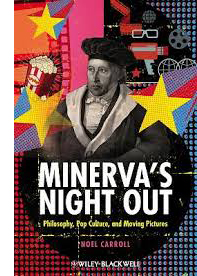 It’s not just quantity, of course. For those of us in media studies, Carroll has been the most well-informed and adroit analyst of trends in film theory. His Philosophical Problems of Classical Film Theory (1988), Mystifying Movies: Fads and Fallacies in Contemporary Film Theory (1988), and Post-Theory: Reconstructing Film Studies (1996, coedited with me) have proven enduring contributions to the debates about the best ways to understand the nature and functions of cinema. He is, as you can tell, a controversialist. Like all good philosophers, he’s devoted his life to getting the ideas right. Over the same period, Carroll has proven himself a wide-ranging practical critic, discussing classic silent films (especially comedy), modern avant-garde work, and Hollywood movies from the 1930s to the most recent releases. This isn’t to slight his important work as a dance and television critic as well.
It’s not just quantity, of course. For those of us in media studies, Carroll has been the most well-informed and adroit analyst of trends in film theory. His Philosophical Problems of Classical Film Theory (1988), Mystifying Movies: Fads and Fallacies in Contemporary Film Theory (1988), and Post-Theory: Reconstructing Film Studies (1996, coedited with me) have proven enduring contributions to the debates about the best ways to understand the nature and functions of cinema. He is, as you can tell, a controversialist. Like all good philosophers, he’s devoted his life to getting the ideas right. Over the same period, Carroll has proven himself a wide-ranging practical critic, discussing classic silent films (especially comedy), modern avant-garde work, and Hollywood movies from the 1930s to the most recent releases. This isn’t to slight his important work as a dance and television critic as well.
This focus on film theory stems from the fact that Noël’s first Ph.D. degree was in film studies. But soon afterward he went on to get a second Ph.D. in the philosophy of art. His cinema research was always philosophically informed, but once he became a card-carrying philosopher, he commuted between two academic areas. He helped found the broader movement called Philosophy of Film, and he continues to write on a lot of different topics. His Humour: A Very Short Introduction is due out in a couple of weeks.
Minerva’s Night Out scans the range of his interests—not only all types of media (which he genuinely enjoys) but a variety of the philosophical puzzles they pose. These he tackles with verve, patient but not plodding analysis, and a range of references that make you wonder if this guy has seen and read pretty much everything.
Here’s the sort of thing that Noël thinks about. We all know that to enjoy a movie fully we often have to appreciate the way in which a star’s performance builds on previous roles. But there’s a problem. The fictional world of a film makes only certain types of knowledge relevant to our experience. At the center of this knowledge is what Carroll calls the “realistic heuristic,” the premise that all other things being equal, the things happening in the fiction are assumed to operate under the laws of our everyday world. Sherlock Holmes (whether incarnated by Basil Rathbone or Benedict Cumberbatch) is presumed to have lungs like the rest of us, unless we’re told otherwise. Likewise, it is true in the fiction that a room’s walls are solid, while they might in reality be fake. If I see the walls as painted sets or green-screen mattes, then I’m not responding to them as part of the story world.
The same attitude shapes our sense of the unfolding plot. Armed with the realistic heuristic, we have to assume that characters’ destinies are open, that many things can happen to them (as with us). But the principles by which a movie fiction is constructed—say, boy gets girl—aren’t part of our realistic heuristic. “What we believe is probable of a movie qua movie is radically different from what we believe to be probable in a movie conceived as a credible fictional world.” Movie lore tells us that boy will get girl, but to grasp and respond to the story emotionally, we have to feel in doubt. (Perhaps this is what people mean when they say that a mistake in the movie, or a distraction in the auditorium, takes them “out of the movie.” We’ve left the fiction.)
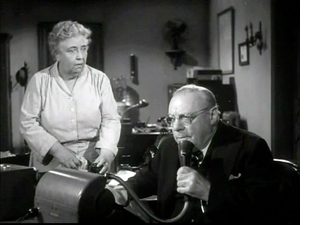 Similarly, movie lore connects the Ringo Kid of Stagecoach to Rooster Cogburn of True Grit (the original) because John Wayne portrays both. Yet the characters live in different, sealed-off story worlds. Ringo and Rooster have no knowledge of each other. Barring transmigration of souls, how can their connection be part of our experience of either movie as a consistent fiction?
Similarly, movie lore connects the Ringo Kid of Stagecoach to Rooster Cogburn of True Grit (the original) because John Wayne portrays both. Yet the characters live in different, sealed-off story worlds. Ringo and Rooster have no knowledge of each other. Barring transmigration of souls, how can their connection be part of our experience of either movie as a consistent fiction?
Carroll comes up with an ingenious explanation. Movies summon up star personas in the manner of allusions. Just as our experience is enhanced when we see a movie refer to another movie—Carroll’s example is a citation of Rocky in In Her Shoes—so do our mind and emotions respond to the presence of the star, as either a continuing allusion throughout the film or a one-off one, as with a cameo or walk-on. As he often does, Noël points out that practicing filmmakers use the concepts he elucidates. “Allusive casting” became part of the 1970s trend of paying homage to old Hollywood, but even in the studio era it wasn’t unknown. Carroll points to The Bigamist (above left), in which somebody says another character looks like Edmund Gwenn. Of course said character is played by Edmund Gwenn.
I’ve shrunk down Carroll’s line of reasoning to give you the flavor of the way he thinks. His piecemeal approach to theory focuses not on loosely named topics but specific questions. For example:
What if anything justifies us talking about popular culture as all one thing?
How do fiction films engage us in the emotional lives of their characters? Hint: It’s not through identification.
What makes us laugh at Mr. Creosote, rather than be horrified or disgusted by his vomit-laced gluttony?
How does a tale of dread, such as Poe’s “The Black Cat,” differ from a horror story?
Why should we care about Tony Soprano, who barehanded commits “crimes of which I don’t even know the names”?
Are the feelings awakened by art akin to friendship?
What role do moral emotions, such as the sense of community, play in our response to characters?
As for the jokes, they’re not of the esoteric academic type but rather straight-out funny. Just one essay, on the vague/implausible (you pick) notion that modernity (traffic, window displays, lotsa flashing lights) changed the very faculty of human perception:
The human eye rarely fixates; saccadic eye movement is the norm. We did not suddenly become attention-switching flâneurs in the late nineteenth century; we have been natural-born flâneurs since way back when.
No amount ot cultural conditioning will succeed in making normal viewers worldwide literally see human faces as cross-sections of centipedes.
I’m sure he’d give any indie filmmaker the rights to make Natural Born Flâneurs.
Viewers and their habits
Natsukawa Shizue in Town of Hope (Ai no machi, 1928).
Carroll tries to figure out certain logical conditions on spectators’ experience in general. That’s one province of film theory. But he’s also sensitive to the constraints on those conditions, the ways that historical and institutional circumstances can shape how viewers watch movies. (That’s part of the star-as-allusion argument.) Other researchers, historians by trade but sensitive to theoretical implications, have tried reconstructing the activities of theatres, trade personnel, and audiences in particular times and places.
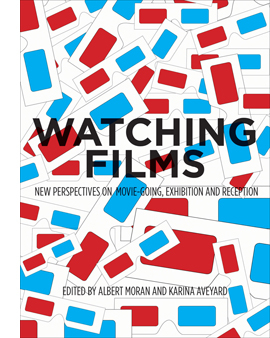 A good cross-section of approaches has just appeared from Karina Aveyard and Albert Moran. Their anthology Watching Films: New Perspectives on Movie-Going, Exhibition and Reception contains 22 chapters of empirical research spread across the Europe, New Zealand, Australia, and the U.S. The researchers take us to particular cities and towns (Antwerp, Nottingham, and the Scottish Highlands) and to various points in history, from the 1920s to the present, passing en route the arrival of TV and the effects of the VHS revolution. There are also considerations of early reception theorists like Barbara Deming, along with studies of fan activities in Italy and elsewhere. Altogether, you couldn’t ask for a more enticing sampler of contemporary strategies for studying how audiences interact with cinema. Multiplicity long preceded the multiplex.
A good cross-section of approaches has just appeared from Karina Aveyard and Albert Moran. Their anthology Watching Films: New Perspectives on Movie-Going, Exhibition and Reception contains 22 chapters of empirical research spread across the Europe, New Zealand, Australia, and the U.S. The researchers take us to particular cities and towns (Antwerp, Nottingham, and the Scottish Highlands) and to various points in history, from the 1920s to the present, passing en route the arrival of TV and the effects of the VHS revolution. There are also considerations of early reception theorists like Barbara Deming, along with studies of fan activities in Italy and elsewhere. Altogether, you couldn’t ask for a more enticing sampler of contemporary strategies for studying how audiences interact with cinema. Multiplicity long preceded the multiplex.
A similar approach, but focused with razor acuity on a single country and period, is Hideaki Fujiki’s Making Personas: Transnational Film Stardom in Modern Japan. This book is an expedition into a nearly sunken continent, Japanese film of the silent era. Frustratingly few films have been preserved from those years, but paper documents abound. Fujiki has made intense use of them to answer the question: What were the cultural causes and results of the early star system in Japan?
The answers are rich and detailed. The very first stars weren’t on the screen at all; they were the benshi who narrated the silent program. Hideaki goes on to trace the career of the paradigmatic male star, Onoe Matsunosuke, and to show how his main traits (virtuosity and stature as “great man”) were reinforced by a troupe-based business model. Later chapters focus more on female stars, with emphasis on the influence of American actresses like Clara Bow. The flapper figure shaped not only Japanese female performers but women in real life.
Fujiki traces in some detail how the “modern girl” or moga floating through Ginza owed a good deal to Hollywood movies. He makes good use of what films survive from this period, particularly The Cuckoo (Hototogisu, 1922) and Town of Love (Ai no machi, 1928). In-depth analysis of the star image Natsukawa Shizue, above, allows him to discuss fan culture and movies’ role in accelerating trends in fashion and advertising. In all, Making Personas is a fascinating consideration of stardom as both an industrial and social construction in one of the world’s most important national traditions.
Education and environment
Institutions of another sort feature in two impressive books from the prolific Mette Hjort. She has had the very good idea of assembling documentation about how film schools work. How do different schools, academies, and more informal agencies understand the craft of filmmaking? What ethical values and social commitments are brought to the classroom and enacted in the production process? What are the histories of film schools around the world?
The answers come in two packed anthologies, The Education of the Filmmaker in Africa, The Middle East, and the Americas, and The Education of the Filmmaker in Europe, Australia, and Asia. From these we learn of the creative practices put into action by institutions in Nigeria, Palestine, Denmark, the West Indies, China, Hong Kong, Vietnam, Sweden, Germany, Australia, Japan, and many other localities. We get a real sense of intercultural communication and its breakdowns. Rod Stoneman points out that Tinpis Run, Papua New Guinea’s first indigenous feature, demanded postproduction discussions when outsider viewers couldn’t distinguish the villages presented in the story.
Things happen in these places that would astonish students at UCLA and NYU. Hamid Naficy tells of taking his Qatar students to Tanzania, where they worked on research projects only after spending the morning doing clerical and custodial work in schools and hospitals. We learn of children’s filmmaking initiatives in Mexico City, programs for at-risk youths in Brazil’s City of God favela, and students making photo and sound montages in Calcutta. One purpose of Mette’s collections is to remind us that film training goes far beyond getting your MFA and a showreel on a maxed-out credit card.
Hjort’s initiative, while already stimulating, ought to be continued and enriched. People are starting to understand the importance of film festivals within film culture—as distribution mechanisms, publicity arms, and in a roundabout way feedback systems shaping production. (One essay, by Marijke de Valck, points out the move by festivals toward film training.) More generally, we need to understand film education at all levels as shaping film production and film audiences.
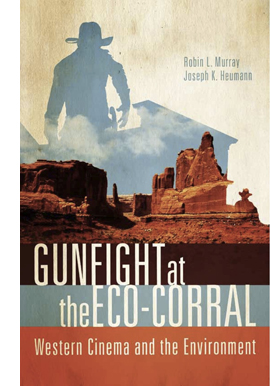 Hjort’s introduction emphasizes that institutional politics are always related to larger political and cultural concerns. Social implications of filmmaking are brought to the fore in another emerging area of research. As each day seems to signal a new ecological disaster, it’s timely that a critical school has emerged to track how films and TV represent our relation to nature and technology. Among the scholars working prolifically in this area are Robin L. Murray and Joseph K. Heumann.
Hjort’s introduction emphasizes that institutional politics are always related to larger political and cultural concerns. Social implications of filmmaking are brought to the fore in another emerging area of research. As each day seems to signal a new ecological disaster, it’s timely that a critical school has emerged to track how films and TV represent our relation to nature and technology. Among the scholars working prolifically in this area are Robin L. Murray and Joseph K. Heumann.
Their first book, Ecology and Popular Film: Cinema on the Edge argues that apart from films like An Inconvenient Truth, which wear their green politics on their sleeve, there’s a much bigger and broader tradition of films about humans and the environment, ranging from fictional films with explicit messages, like Happy Feet (2006), to films with unintentional ones, like The Fast and the Furious (2001).
As “second-wave” practitioners of eco-criticism, Murray and Heumann aren’t much concerned with cheerleading or finding villains. They want to explore how media representations of the environment have responded to various cultural pressures. Their two most recent books are good examples. That’s All Folks? (2009), building on their analysis of Lumber Jerks in their first book, concentrates on American animated features. They perform careful symptomatic readings while also providing industrial context, such as the tactics by which Lucas and Spielberg adapted to the growing dinosaur craze of the 1990s.
In Gunfight at the Eco-Corral (2012), Murray and Heumann tackle the Westerm on similar grounds, ranging from Shane and Sea of Grass to There Will Be Blood and Rango. Reading these chapters I was reminded how often the genre’s plots hinge on disputes over natural resources. Water, minerals, timber, grazing land, and what the authors call “transcontinental technologies” like the telegraph and the railroad are at the heart of classic Westerns, and the genre’s formulaic conflicts often have strong ecological resonance. This is the sort of criticism that refreshes your vision of movies you think know very well.
Their next book, Film and Everyday Eco-disasters is due out in June.
Things stick together
Lone Survivor (2013).
Finally, two more books merging theory and practice—but from opposite ends of the spectrum. One question that intrigues me involves coherence and cohesion in film. Roughly speaking, coherence involves the way the whole movie hangs together. If it’s a narrative film, how do the scenes or sequences fit into the larger plot? If it’s not narrative, what other principles organize the whole shebang? Cohesion involves how adjacent parts fit together—shot against shot, sequence to sequence. Both these concepts have practical implications, since every filmmaker confronts concrete choices about them in scripting, shooting, and editing.
Michael Wiese has contributed enormously to our understanding of filmmaking practice by publishing a series of books on cinema craft. The most recent one I know is by Jeffrey Michael Bays and it bears directly on cohesion. It’s called Between the Scenes: What Every Film Director, Writer, and Editor Should Know about Scene Transitions. Bays himself has written and directed films, written radio dramas (a great place to study transitions), and published books on filmmaking.
Between the Scenes is an entertaining and damn near exhaustive account of the ways that images and sounds can tie one scene to another. Bays considers aspects of space, like location or objects or actors; time; and visual graphics. The book also shows how sounds can bind scenes or emphasize sharp contrasts. In the example from Lone Survivor above, a soft whir of helicopter blades is heard over the first shot and grows louder when we move from the map to the landing area.
In a web essay called “The Hook” I explored some aspects of this process, but Bays goes into much more detail with many recent examples. He also raises ideas I never considered. For example, if we think of narratives as people traveling from one place to another (and most narratives are that, at least), then every filmmaker faces a choice: Show the journey or don’t show it. And if you show it, what parts and why and what does it tell us about the character? The larger point is: “Make sure you know where every character goes between every scene.” Thinking about this suggests ways to enrich your presentation, and it allows the characters—if only in your imagination—to inhabit a more fleshed-out world. Ideas like this can provoke everyone, filmmakers and film scholars alike.
 Small-scale links between parts are considered more theoretically in Chiao-I Tseng’s Cohesion in Film: Tracking Film Elements. Trained in functionalist linguistics, Tseng brought her expertise to bear on film analysis. The results show a remarkable kinship between devices in language and certain cinematic transitions. Such linguistic functions as saliency (what stands out) and presumption (what can be taken for granted) are found in audiovisual texts too. For example, a shot taken over one character’s shoulder tends to lessen that character’s saliency and make another character, the one we see more clearly, more prominent.
Small-scale links between parts are considered more theoretically in Chiao-I Tseng’s Cohesion in Film: Tracking Film Elements. Trained in functionalist linguistics, Tseng brought her expertise to bear on film analysis. The results show a remarkable kinship between devices in language and certain cinematic transitions. Such linguistic functions as saliency (what stands out) and presumption (what can be taken for granted) are found in audiovisual texts too. For example, a shot taken over one character’s shoulder tends to lessen that character’s saliency and make another character, the one we see more clearly, more prominent.
This example is simple, but once Chiao-I gets going, she’s able to show how nearly every cut or camera movement can be seen as activating a unique tissue of cohesion devices. The words in a paragraph not only refer to ideas or things; they also link to other words in the paragraph and in the larger discourse. Similarly, in film, different aspects of the images and sounds stand out and adhere to one another instant by instant. Tseng’s analyses of passages in Memento, The Birds, The Third Man, and other films are accompanied by equally close studies of television commercials and educational documentaries. At the end, analysis is supplanted by synthesis, as she shows how the configurations she has pulled apart coalesce into levels that highlight characters and actions. It’s a fresh way to think about how we understand films within genres and stylistic traditions.
In effect, she’s showing the fine-grained patterns that emerge from the choices every filmmaker faces. It would be fascinating to sit in on a dialogue between Bays and Tseng, for they belong to the same community, or so I think anyhow. We’re all trying to understand aspects of cinema, and by focusing on certain phenomena rather closely, we have a good chance to understand them better.
So to the filmmaker who’s skeptical of theory, I say: We can’t think clearly without concepts, or talk clearly without terms. We need to develop rigorous ideas and arguments (i.e., theory) to understand film as best we can. But to the would-be theorist I say: Keep fastened on the look and feel of the films, and test your ideas and arguments not only against them, but against what you can find out about the craft of cinema, in all its historical implications.
I was pleasantly surprised, after I’d decided to talk about these books, to find work by Kristin and myself cited in some of them. Remaining coldly objective, however, I didn’t let these mentions diminish my praise.
Rango (Gore Verbinski, 2011).
All play and no work? ROOM 237
Room 237 (2012).
DB here:
Rodney Ascher’s Room 237 gathers the thoughts of five people concerning the deeper, or wider, or just awesomer meanings evoked by Stanley Kubrick’s The Shining. Those thoughts will strike many viewers as fairly far out there. Me, not so much.
Over the top
Room 237 adroitly blends several documentary genres. It recalls Cinemania and Ringers in its investigation of fan cultures. But instead of focusing on the personalities and lifestyles of the fans, Ascher concentrates on their readings of the movie. We never see the commentators. In this respect, it evokes the newly emerged genre of video essays as practiced by Kevin B. Lee and Matt Zoller Seitz. Yet it doesn’t offer itself as an earnest contribution to the critical conversation because Ascher freely intercuts stills and shots from other films, often to ironic effect.
In all, his film has the quizzical, gonzo flavor of an Errol Morris movie, minus the talking heads. But Morris is as interested in people as he is in their ideas. Ascher is interested in the ideas, and the way they swarm over and burrow into a film we thought we knew.
So he performs the sort of surgery more appropriate to the Zapruder footage. In the boldest test of cinematic Fair Use I’ve ever seen, a great many clips from the Warner Bros. release are run, slowed, halted, backed up, blown up, and overwritten as support for the interviewees’ claims. Ascher never tries to counter their arguments; at times he supplements them with extra evidence.
The results seem, to many, at best far-fetched and at worst (or best, from an entertainment standpoint), wacko. One of Ascher’s interviewees believes that The Shining is a denunciation of the genocidal destruction of Native Americans. Another takes the film as an exploration of the Theseus myth. Another believes that the film makes references to the Holocaust. Another finds a welter of subliminal imagery pointing to “a dark sexual fantasy.” Another sees the film as Kubrick’s apologia for staging the faked footage of the Apollo 11 moon landing.
Are these interpretations silly? Having spent forty-some years teaching film in a university, I found much of them pretty familiar. Some of the specifics were startling, but I’ve encountered interpretations in student papers, scholarly journals, and conference panels that had a lot of similarities.
If you think that this just proves that all film interpretation is ridiculous, you can stop reading now.
Because most film enthusiasts think that at least some movies need interpreting. We assume that like artists in other media, some writers and directors are using their medium to transmit or suggest meanings. And if a movie doesn’t express its makers’ ideas, perhaps it can still bear the traces of ideas out there in the culture. This “reflectionist” idea, tremendously popular among both journalists and academics, allows us to interpret even escapist fare.
Our interpretive itch has been around for a long time. Centuries of commentary have accrued around the Bible, the Torah, the Koran, and other texts deemed sacred. Secular texts, from Homeric epics to last month’s bestseller, have been scoured for hidden meanings too. The search hasn’t just been confined to literature, of course. An entire school of art history, called iconology, has devoted itself to deciphering objects, compositions, and other features of paintings. Even musical pieces without verbal texts have been “read.”
If at least some movies need interpreting, The Shining would seem to be a prime candidate. The film creates many questions about the reality of what we see and hear, and it seems to point toward regions larger than its central tale of terror. The director was one of the most ambitious filmmakers of the twentieth century, a film artist who could use a genre-based project like the famously puzzling 2001: A Space Odyssey (1968) to convey ideas about the place of human history in the cosmos. Why couldn’t he do the same thing with a Stephen King horror novel?
What’s wrong, then, with the five critics’ readings? Why do many viewers find them strained and forced, even loopy? One of the many virtues of Room 237 is that it forces us to ask: What do we do when we interpret movies? What makes one film interpretation plausible and another not? Who gets to say? What historical factors lead ordinary viewers to launch this sort of scrutiny?
All in the family
We all grant that movies have conventions. In an action picture, the bad guys have extraordinarily bad aim, except when it comes to winging the hero or plugging his best friend. Similarly, film criticism relies on a batch of conventions about what things to look for and how they should be talked about. No quickie film review, for instance, is complete without discussing acting.
Interpretation, a central activity of film criticism, has its conventions as well, and the Room 237 interviewees make some moves that are common to interpretation in academe and elsewhere. For one thing, they assume that The Shining is more than a standard-issue horror movie. Most cinephile and academic critics would agree that we have to go beyond this movie’s literal level.
Some of the Room 237ers’ conclusions echo critically respectable interpretations already out there. One idea held by other critics is that the film is to some degree a parody or critique of horror conventions. Another is the conviction that the film says something about the repression of the Native American population. The Overlook Hotel is built on tribal burial grounds, a history that hints an earlier, oppressed America returning to avenge a great wrong.
Other Room 237 interpretations don’t show up in the mainstream critical literature, but they aren’t unknown in wider traditions of interpretation. Take numerology. Some interpreters of Biblical scripture find multiples of seven to be of divine significance, and so does the Holocaust advocate in Ascher’s film. According to him, the novel Lolita, which Kubrick adapted, makes 42 a symbol of fate. In The Shining, it becomes a symbol of “danger and malevolence and disaster.” Why? Multiply 2 x 3 x7 and you get 42. Danny wears a jersey with the number 42, there are at one point 42 vehicles in the hotel parking lot, and 1942 is the year in which Hitler launched the Final Solution.
Similarly, anagrams aren’t unknown in some interpretive traditions. Scholars have claimed to find in Shakespeare’s plays encoded references to the real author (Marlowe or Francis Bacon or the Earl of Oxford). Ferdinand de Saussure, one of the founders of modern linguistics, whiled away his later years with detecting anagrams in Latin poetry. Joining up with this method, the interviewee who sees The Shining as an apology for faking the Apollo landing rearranges the letters on the room key to spell out MOON ROOM. And the moon, says the critic, is 237,000 miles from our earth.
I grant you that such cabalistic maneuvers aren’t common in film criticism. But plenty of others on display in Room 237 use the same reasoning routines that we find in consensus critical writing.
What do I mean by reasoning routines? When we interpret a movie, we’re making inferences based on discrete cues we detect in the film. What cues we pick out and what inferences we draw vary a lot, but the process of inference making tends to follow certain conventions.
Consider the claim that Kubrick is warning that we shouldn’t expect a conventional horror film. A more mainstream critic would point to the flamboyant performance of Jack Nicholson, at once grotesque, comic, and ominous. This would seem to be a strong ensemble of cues asking us not to take the film straight, and perhaps implying that it’s a send-up, in a grim register, of its genre. But none of our 237ers mention this cue as a basis for their interpretation.
Instead, they scan the setting for disparities. The hotel’s architectural features sometimes differ from one shot to another. A chair is present in one reverse shot of Jack, but in the next reverse shot, it’s gone. The hotel geography can’t be plotted consistently. Moreover, one of Wendy’s visions during her desperate flight through the corridors at the climax invokes the clichés of ordinary shockers: dust, cobwebs, and skeletons—all the paraphernalia that the film has studiously avoided up to this point. These anomalies encourage the interpreter to see the film as parodying typical horror movies. The 237 critics are picking out cues less obvious, they would say, than Nicholson’s over-the-top acting.
Making meaning, or making up meanings?
Ascher’s interviewees don’t always go for minute cues. They focus as well on many items that conventionally invite symbolic interpretation. Mirrors signal any sort of reversal, such as Danny’s backward steps through the maze or the film’s symmetrical beginning and ending. Something open—a door, a character’s eyes—suggests knowledge and acceptance; something closed, like elevator doors, suggests repression. If a character enters a space, that space can be taken as a projection of the character’s mental state, as when Danny nears his parents’ bedroom and gets into “his parents’ headspace,” as one 237 critic puts it. Another commentator suggests that Jack’s job interview at the beginning of the film might be entirely his hallucination, a question raised by academic critics as well. Such speculations on the border between the subjective and objective are commonplace in discussions of horror, fantasy, and that in-between register known as the fantastic.
Puns are another time-tested inferential move. You can find a cue in the mise-en-scene and then “read” it with a verbal analogy. Snow White’s Dopey on Danny’s door suggests that the boy doesn’t yet realize what’s going on; but when the dwarf disappears, Danny is no longer “dopey”. A crushed Volkswagen stands for Kubrick’s telling King that his artistic “vehicle” has obliterated the novelist’s original “vehicle.” Abstract patterns in carpeting become Rorschach tests: Are those shapes mazes? Phalluses? Wombs? NASA launching pads? Mainstream critics might not fasten on these particular cues, but many wouldn’t resist the urge to find puns. After all, even Freud interpreted a dream in which his patient got kissed in a car as exhibiting “auto-eroticism.”
The Room 237 critics, following tradition, let the cues and inferences lead them to what I call both referential and implicit meanings. Referential meanings involve concrete people, places, things, or events. Spielberg’s Lincoln refers to a specific historical context and people and events in it. Implicit meaning is more abstract and is something we might expect to be intended by the filmmaker. So, for instance, Lincoln could be interpreted as about the necessary mixture of principle and expediency in politics; to achieve virtuous policies, you may need to cut moral corners.
The 237ers make use of different degrees of referential meaning. The Shining makes clear references to the Native American motif, not only in the hotel’s décor but the manager’s line of dialogue indicating that the building rests on burial grounds. That line is a rather explicit cue, and one that many non-237 critics have taken up. In a similar vein are the mythological references; both Juli Kearns in the film and several academic critics have discussed the the maze/ labyrinth imagery as citing the legend of the Minotaur.
There are more roundabout cues to inferences about the Holocaust. Kubrick might have included a photo of Nazis or Prussian generals in the Overlook’s Gold Room salon, but he didn’t. So the critic defending the Holocaust reading has to look for what we might call “hidden references”—the numerology we’ve already seen, along with the German-made typewriter on Jack’s desk, which is an Adler (“eagle,” symbol of Nazism). There’s also a dissolve that, according to another critic, gives Jack a Hitler mustache.
The Room 237 critics gesture toward implicit meanings too. The Playgirl magazine that Jack is reading when he waits in the lobby suggests that troubled sexuality is at the center of this maze—a suggestion made more explicit in the fateful Room 237, where a beautiful woman, upon embracing Jack, turns into a haggard zombie. The references to both the North American and German genocides suggest the film induces us to reflect on the cruelty of those events. More broadly, one critic believes that the film has far-reaching thematic import: The Shining is about “pastness” itself, about coming to terms with history.
To be convincing, though, an interpretation can’t merely take a one-off cue to make references or evoke themes. What really matters are patterns.
Patterns of associations
Interpreters typically gather cues into patterns and then use them to bear thematic meanings. One instance of this maneuver comes early on in Room 237, when Bill Blakemore, proponent of the Native American genocide hypothesis, is attracted to a lone Calumet baking-powder tin, turned toward us on a shelf. Not only does the label show a tribal chief, but the plainness of presentation emphasizes the original meaning of calumet, the tobacco pipe used in Amerindian peace brokering. But that might be a one-off occurrence. Later, however, other Calumet tins are massed on another shelf–but turned from us. It’s not enough that the can has now been repeated. The change, Blakemore proposes, indicates that the original, straight-on image has turned into something hidden and dishonest—the destruction of the tribal population. The spatial opposition frontal/oblique has been made to bear a thematic difference between honesty and betrayal.
A similar duality, with a punning tint, is raised when Kearns traces how she came up with the Minotaur hypothesis. She points out that a skier poster (to her eyes, resembling a Minotaur’s silhouette) stands opposite a rodeo poster (“Bull-man versus cow-boy”). The poster led her to realize that the Minotaur sits at the center of a cluster of images that recur in the film. He presides over the labyrinth that is the hotel, which, Kearns argues, has an impossible geography, while the intertwined logo of the Gold Room recalls Theseus’s thread. In his alternate identity Asterios, the Minotaur suggests stars, which in turn suggest movie stars (who, we’re told, have stayed at the Overlook). The ski poster reads “Monarch,” which in a sense the Minotaur is, and we learn that royalty have visited the hotel too.
Or take the Holocaust reading. Apart from the fateful 42 motif, the Adler typewriter does other work. Its name (“eagle”) evokes the emblem of the Reich, but an eagle is also a prominent American icon. So the critic adds that Kubrick always uses an eagle to symbolize state power. How then to link it to Germany? The typewriter, as a machine, evokes the bureaucratic efficiency of Hitler’s mass deportations and executions. To back this up, the critic recalls Schindler’s List, in which typewriters figure extensively.
Such expanding clusters are common in interpretive activity because artworks often ask us to tease out associations. Early in The Shining, the Torrance family talks about the Donner party. We’re invited to see the reference as conjuring up slaughter, isolation in a snowbound environment, and the collapse of civilized restraints—just what the film will give us. Critics of all stripes track the dynamic of the artwork by creating associative patterns out of repeated elements. When Wendy and Danny watch the film Summer of ’42 on TV, it’s not the 42 that attracts the distinguished academic critic James Naremore. He links the embedded film about the sexual attraction between an older woman and a younger man to the moment when Danny runs out of the maze and kisses Wendy on the lips. These moments are part of a constellation of images and events marking the film as “flagrantly Oedipal,” in that it presents the son’s struggle against the hostile father. Naremore is able to build on this cluster to suggest that the film is unusual in rehearsing different, non-Freudian aspects of the Oedipus myth.
You might object that, unlike Naremore and other professionals, the critics in Room 237 build up associations from their personal experiences rather than what’s objectively on the screen. Blakemore says that he noticed the Calumet label because he grew up in Chicago near the Calumet River and as a child he gathered Indian pottery. Yet the conventions of mainstream movie reviewing allow critics to look inward too. Jonathan Rosenbaum opens his piece on James Benning’s El Valley Centro:
About halfway through I found myself, to my surprise, thinking about Joseph Cornell’s boxes, those surrealist constructions teeming with fantasy and magic—dreamlike enclosures that make it seem appropriate that Cornell lived most of his life on a street in Queens called Utopia Parkway.
The only difference between Rosenbaum’s associational links and Blakemore’s would seem to be the cultural level of the references. Why should the amateur not be allowed to import less arcane personal associations into an interpretation?
Finally, you might object that the Room 237 critics are too focused on trying to infer Kubrick’s intentions. Kubrick had wanted to make a film on the Holocaust at some point; he read Raul Hilberg’s Destruction of the European Jews and corresponded with the author. Kubrick also read Bruno Bettelheim’s Uses of Enchantment, a Freudian explanation of fairy tales; hence the Hansel and Gretel and Big Bad Wolf references in the film. One Room 237 critic says that Kubrick was bored after making Barry Lyndon and wanted to make a movie that reinvented cinema. Yet, again, journalistic critics commonly make assumptions about what the filmmaker is up to. Even academics, trained to believe in “the intentional fallacy” and to “never trust the teller, trust the tale,” can indulge in hypotheses about directorial purpose. In explaining the eccentricities of the lead performance, Naremore notes that in interviews, Nicholson reported that Kubrick told him that “real” performances aren’t always interesting.
Tie me up! Tie me down!
Apollo 11 moon landing, July 1969.
For mainstream film criticism, however, the patterns and the significance-laden associations they trigger have to be constrained somehow. Not everything is relevant to the implicit meanings of the film. This condition, I think, shows the real gap between the 237ers and the pros. One interviewee’s enthusiasm marks this difference: Kubrick, he says, is “thinking about the implications of everything that exists.” No mainstream critic would dare make this move.
What are the constraints on interpretation within the community of publishing critics, either journalistic or academic? Here are some common ones.
Salience: The patterns and associations are more plausible if they’re readily detectable– if not at first, then on subsequent viewings. The case gets stronger if the motif is reiterated along many channels—image, dialogue, music, sound effects, written language. The Native-American genocide association is moderately salient, present in both items of décor and in Ullman’s line about the burial grounds. Accordingly, many viewers have picked up on it. On the other hand, even repeated viewings don’t help us (me, at least) to identify the magazine as Playgirl.
Coherence: The patterns and associations are more plausible if they’re related functionally to the narrative—not just to single moments but to its overall development. Most critics writing about The Shining assume that it’s centrally about the disintegration of the family. They have gone on to relate this to the way that the delusions of patriarchy subject women and children to its control. (That common academic trope of “the crisis of masculinity” hovers nearby.) This thematic thrust can be traced scene by scene, and the motifs of fairy tales, American history, and the Minotaur can blend with specific plot twists and character presentation. Some of the Room 237 critics’ readings mesh with the arc of the narrative, but many, such as certain overlays during dissolves, seem unmotivated by narrative factors.
Congruence with other relevant artworks: The patterns and associations gain plausibility if they can seem congruent with other works by the same artist or in the same genre. For example, the uncertainty about whether Jack is imagining the Gold Room or whether it’s a genuine supernatural entity is characteristic of horror/ fantasy films. Here the 237ers are more in line with their mainstream colleagues. The unresolved ending, leaving us with a puzzle about whether Jack himself is a reincarnation of someone from the past, isn’t out of keeping with the ending of 2001. The room 237 itself, one of Ascher’s critics suggests, is a bit like the old man’s bedroom and the space pod in the earlier film.
Appeal to authorial intention: The critic’s case gains plausibility if people having significant input into the work claim the patterns and associations were deliberately put there. While rewatching The Shining, Nicole Kidman remarked of Kubrick:
“He always said that you had to make sure the audience understood key pieces of information to follow the story, and that to do that you had to repeat it several times, but without being too obvious about it,” Ms. Kidman said. “Here, in this scene, look at how there is this rack of knives hanging in the background over the boy’s head. It’s very ominous, all of these knives poised over his head. And it’s important because it not only shows that the boy is in danger, but one of those very knives is used later in the story when Wendy takes it to protect herself from her husband.”
Most mainstream critics would, I think, find that Kidman’s inference rings true. It picks up a fairly salient cue, it invokes a pattern involving the knives, and it squares with the unfolding of the narrative. She reports that Kubrick understood the need for patterns to have salience, and it seems quite likely that he was the sort of artist to use pictorial prefigurations like this. Note, though, that this shot exemplifies function-driven dramaturgy—foreshadowing—not thematic interpretation.
By contrast, consider the Room 237 critic who takes The Shining to be Kubrick’s apology to his wife for staging the fake Apollo 11 moon landing. As Ascher presents the case, it involves a long chain of causation. It starts from the claim that, whether or not NASA actually sent a crew to the moon, the landing that the public saw was staged. The project needed front-screen projection. Kubrick was the master of those special effects. He agreed to help film the fake landing. Later he felt guilt for it. So by making a film about a husband/wife conflict, Kubrick confesses to his mistake. This backstory would gain a lot of plausibility if a NASA staffer or one of Kubrick’s crew came forward to support any part of it, in the way Kidman offers testimony about Kubrick’s working methods. It would be even better if the Apollo tale could be tied to the specifics of the unfolding narrative. And it would be best if the interpretation of this film didn’t depend on a (questionable) interpretation of another film–the Apollo 11 footage.
The Apollo 11 argument illustrates the risk of appeals to intention: they tend to substitute causal explanations for functional ones. That is, they tend to look for how something got into the film rather than what it’s doing in the film. But that’s a risk that professional critics run as well when they appeal to intention. The problem is just more apparent when the causal story that’s put forward seems tenuous.
I’ve argued that the cue-inference method and the use of association to create patterns aiming at referential and implicit meanings are involved in all interpretations, staid or unorthodox. But the constraints I’ve just sketched aren’t so fundamental to interpretation as such. They typify the established critical institution, which includes journalism high and low, belles-lettres (e.g., The New York Review of Books), specialized cinephilia (eg., Cinema Scope), and academic writing.
Not everybody belongs to that institution. There are other arenas of film criticism, and there’s no mandate that discussion in those realms adhere to the constraints urged by professional criticism. Some readers prefer to muse on barely perceptible patterns, incoherence, unlimited association, and relatively unrestrained speculations about Kubrick’s mental processes. Fans like to think and talk about their love, and anything that gives them the occasion is welcome, no matter what any establishment thinks. To a considerable extent, Ascher’s film documents the habits of folk interpretation.
Some precedents
But why now? Why do amateur critics today launch these ambitious expeditions? The short answer, as so often, would be: Because they can. As Juli Kearns points out, it was thanks to VHS, then DVD, that she was able to scrutinize The Shining. Home video has allowed us, including all the obsessed among us, to halt and replay a movie ad infinitum—a process that Ascher’s own film freely indulges in. I think, though, that there are other historical factors that impel fans to dig ever deeper into the movies they love.
Most obviously, there’s the rise of the puzzle film, the movie that litters its landscape with hints of half-buried meanings. The vogue for this began, I suppose, in the late 1990s with films like Memento, Magnolia, and Primer. Even then, though, there were different constructive options. Primer called out for re-watching because much of its plot was obscure on a single pass; you had to examine it closely to figure out its basic architecture. By contrast, Memento’s principle of reverse chronology was evident on first viewing. I suspect that most viewers, like me, studied the film to pick up the finer points of its form and to try to disambiguate the Sammy Jankis plotline. Still different was Magnolia, with a perfectly comprehensible plot that planted a Biblical citation in its mise-en-scene. In this case, the extra stuff suggested a thematic level that might not be apparent otherwise.
Some critics have objected that the Room 237 critics turn Kubrick’s film into a mere puzzle movie, the implication being that puzzle movies are inferior forms of cinema. Yet I don’t see a good reason to scorn them. Assuming that films often solicit our cognitive capacities, I don’t see why artists shouldn’t ask us to exercise them. Cinema takes many shapes, and one critic’s puzzle (“Rosebud,” “Keyser Söze”) is another critic’s mystery. Some artworks throb with passion; some are more intellectual and austere. There is Mahler, and there is Webern. Even artworks with a lyrical or emotional dimension ask for decipherment and meditation too. Dante explained to his patron Can Grande della Scala that he had laid layers of non-literal meanings into The Divine Comedy. The poem, he explains, is “polysemous.” Its meanings are to be grasped and pondered upon in the manner of Scripture.
Long before puzzle movies came into fashion, literary modernism had assigned readers this sort of homework. The idea of loading every rift with ore was taken quite seriously by T. S. Eliot, who supplied footnotes to The Waste Land. Could you really hope to understand it without reading Jesse Weston’s From Ritual to Romance? James Joyce built so many layers into Ulysses that he had to take a critic aside and explain them to him, so the critic could then publish a guidebook to the novel. Finnegans Wake is supersaturated with references, puns, and esoteric meanings. If ever an artwork needed decoding, this is it. One of the earliest scholarly studies is called A Skeleton Key to Finnegans Wake.
In cinema, Peter Greenaway’s Tulse Luper series seems to be his bid for Joycean stature. More successful has been Godard, who in his mid-1960s films created an aesthetics of dispersal, a display of citational pyrotechnics that reaches its apogee in the Histoire(s) du cinéma. Surely this suite of films has engaged many critics in a process akin to puzzle-solving. More to our point today, we might see Kubrick’s films, especially 2001, as bringing aspects of high modernism into mainstream cinematic genres. We can hardly be surprised that after courting many interpretations of 2001 (whose subtitle cites a classic literary text), this director might be posing us similar tasks in a horror film.
Something else besides the rise of the puzzle film and high-modernist polysemy is probably responsible for the rise of this sort of fan dissection. Throughout history storytellers have experimented with creating what we might call richly realized worlds. Naturalist literature describes fine details of the writers’ society at the time, while Gulliver’s Travels and Looking Backward take us into alternative realms. The rise of fantasy and science-fiction literature has led readers to demand to know the history, lore, and furnishings of the imaginary places they visit. The Lord of the Rings saga, part of what Tolkien called his legendarium, is the obvious prototype, but the tendency to fill every niche of imaginary worlds is there in the Star Wars and Marvel universes too.
Once fans have become accustomed to raking every frame for clues about the plumbing system of the Millennium Falcon, they are going to expect an equal density in ambitious works in other genres. But not all films, or even all genres. I suspect that we won’t get the equivalent of Room 237 for My Fair Lady or Dinner at Eight. Combined with the intrinsic fascination of The Shining, Kubrick’s well-publicized concern for detail in the futuristic 2001 and A Clockwork Orange leads us to expect that a film centered on the enclosed world of the Overlook would yield bounty when scrutinized.
Finally, I should note that the seeming capriciousness of the Room 237 readers has a counterpart in one strain of academic interpretation. Borrowing from both Surrealism and a post-Structuralist concern for a “free play of the signifier,” Tom Conley and Robert B. Ray have practiced a criticism that yields results strikingly similar to the work of Ascher’s interviewees. Ray cultivates free association, as when he puns on characters’ names, and Conley has been known to find, as one Room 237 critic does, significant images in cloud formations.
The only major difference is that these academics typically discount an appeal to the filmmakers’ intentions: that move would inhibit the critic’s free-ranging imagination. Once in a while, the Room 237 critics follow suit on this front. They withdraw from attempts to anchor their readings in Kubrick’s life, thought, and personality. One who appealed to intentions early in the film has abandoned them by the end, and another frankly admits: “One can always argue that Kubrick had only some or even none of these [interpretations] in mind, but we all know from postmodern film criticism that author intent is only part of the story of any work of art.”
One of Ascher’s most engrossing final sequences shows John Fell Ryan’s effort to run The Shining forward and backward at the same time, superimposing them to create startling new images like the one that surmounts today’s entry. Folding the film over onto itself is in the spirit of Conley and Ray’s work, I think. The gesture hearkens back to that “irrational enlargement” of films that the Surrealists sought when they dropped in on the middle of one movie, stayed a little while, and then hurried out to slip into another. (They would have loved multiplexes.) Again, the apparently far-fetched meaning-making strategies of our amateur critics turn out to have some kin in the academic establishment and in the history of artistic culture.
I’ve made Room 237 more solemn than it is. It’s a pleasurable and provocative piece of work. It too would be worth interpreting, but I haven’t tried that here. I’ve used it as a kind of AV demonstration. It handily illustrates how interpreting a movie involves certain informal reasoning routines shared by “amateur” and “professional” critics. The differences between the two camps depend largely on what cues the critic fastens on in the film, what associational patterns the critic builds up, and how strongly the critic subscribes to the professional constraints on inferences.
Whether the cues, the patterns, and the inferences based on them seem plausible depends on what particular critical institutions have deemed worthwhile. Claims that won’t fly in mainstream or specialized cinephile publications can flourish in fandom. The purposes and commitments of these institutions may sometimes overlap, but we shouldn’t expect them to.
My account of these critics’ interpretations is drawn wholly from Ascher’s film. All of the interviewees have published more detailed arguments for their views. Bill Blakemore’s thesis about the film’s portrayal of Amerindian genocide is here. Go here for Juli Kearns’ writings on various aspects of Kubrick’s film. Jay Weidner’s thoughts are here. Geoffrey Cocks’ thesis is laid out in his book The Wolf at the Door: Stanley Kubrick, History, and the Holocaust (2004). Jay Fell Ryan discusses and updates his observations in this tumblr site. See also Ryan’s reflections after seeing Room 237.
There seems little doubt that musical texts featuring a verbal text or carrying a program that the composer has sanctioned (like Tyl Eulenspiegel’s Merry Pranks) can be interpreted in the manner of a novel or painting. Even non-programmatic works without texts have been subjected to interpretation. A still controversial example is Ian MacDonald’s 1990 The New Shostakovich, which launches detailed interpretations of hidden meanings in the composer’s work. For critiques, see Richard Taruskin’s articles in Shostakovich in Context, ed. Rosamund Bartlett, and Shostakovich Studies, ed. David Fanning.
The standard book on secret codes in the Bard is William F. Friedman and Elizabeth S. Friedman, The Shakespearian Ciphers Examined. On Saussure’s search for Latin epigrams, see Jean Starobinski, Words upon Words, trans. Olivia Emmet and “The Two Saussures,” Semiotexte 1, 2 (Fall 1974).
James Naremore’s wide-ranging interpretation of The Shining is in On Kubrick. Dennis Bingham provides a detailed history of journalistic and academic interpretations of Kubrick’s film in “The Displaced Auteur: A Reception History of The Shining,” in Perspectives on Stanley Kubrick, ed. Mario Falsetto, 284-306.
Shane Carruth explains that the puzzle aspect of Primer involves only making chronological sense of the plot, which avoids redundancy to an unusual degree.
It’s just that the way the narrative is constructed, I can see how when the story asks you to pull the threads together that’s probably going to happen where threads are pulled together wrong. I definitely didn’t set up this narrative to be open to interpretation. I mean, except for a few things. For the most part, the information is in there to have a very concrete answer as to what is happening in the narrative.
Some critics have worried that Ascher’s film gives viewers an impoverished view of what film criticism is. See for instance Girish Shambu’s comments here. For my part, I doubt that viewers come away believing that the views of these interviewees are typical of criticism as practiced in the mainstream. Nor do I see why Ascher’s movie needs the bigger dose of Theory that Girish prescribes. For my take on Theory (as opposed to theories and theorizing), see the book I edited with Noël Carroll, Post-Theory:Reconstructing Film Studies.
There’s another issue. Like Girish, Jonathan Rosenbaum reprimands the 237 critics for turning The Shining into a puzzle movie.
One way of removing the threat and challenge of art is reducing it to a form of problem-solving that believes in single, Eureka-style solutions. If works of art are perceived as safes to be cracked or as locks that open only to skeleton keys, their expressive powers are virtually limited to banal pronouncements of overt or covert meanings.
I’ve already proposed that a problem-solving approach need not reduce the artwork to a bloodless abstraction. (By the way, I don’t see puzzle-solving and problem-solving as quite the same; I’d say that a puzzle is a particular kind of problem.) But perhaps we should read Jonathan’s first sentence as objecting only to problem-solving approaches that posit “single, Eureka-style solutions.” That would rescue Eliot and Joyce, perhaps, although realizing that Ulysses is a remapping of The Odyssey is something close to a Big Solution to the novel.
In any case, it’s not clear that the 237ers are absolute in their arguments, at least not all the time. The last section of the film chronicles them backing away from their own machinery, confessing that there are dimensions to the film that they haven’t yet grasped, acknowledging that it remains elusive, mysterious, confusing, and, as Dante or a modern theorist might say, polysemous. Moreover, it seems clear that these critics all acknowledge the “expressive powers” of The Shining. They all testify to having been deeply shaken by it; that’s what fuels their urge to probe it. They just claim, like many critics, that the film’s significance extends beyond the visceral and emotional arousal it creates.
On richly realized worlds: J. R. R. Tolkien chose the Latin term legendarium to characterize the entire body of his writings set on the fictional planet Arda, (primarily on the continent of Middle-earth) and the universe in which it exists. The legendarium includes works published during his lifetime, The Hobbit, The Lord of the Rings, and The Adventures of Tom Bombadil, as well as posthumous publications edited by his son Christopher, The Silmarillion, “The Quest of Erebor,” and The Children of Hurin. Not strictly speaking part of the legendarium but closely related to it are the numerous drafts published as Unfinished Tales and the twelve-volume “The History of Middle-earth” series, as well as previously unpublished drawings and maps collected by Wayne Hammond and Christina Scull in J. R. R. Tolkien: Artist & Illustrator and The Art of The Hobbit. (Kristin wrote this paragraph, as you can probably tell.)
For samples of the post-Structuralist interpretative modes I mention, see Robert B. Ray, The Avant-Garde Finds Andy Hardy, and Tom Conley, Film Hieroglyphs.
In another entry I suggest that interpretation is only one critical activity we might pursue. On contemporary Hollywood cinema’s penchant for puzzle films and richly realized worlds, see my book The Way Hollywood Tells It. In Making Meaning: Inference and Rhetoric in the Interpretation of Cinema I try to show that just as we can analyze the conventions of a genre or mode of filmmaking, we can analyze the conventions of film talk. It’s one thing that I think a poetics of cinema brings to the table: an effort to disclose what principles shape a critical argument. As for my own tastes, I value consistency, coherence, constrained ascriptions of intention, and historical plausibility in interpretations. But in my own research, I favor analyzing films’ functional dynamics over hunting down hidden meanings.
P.S. 7 April: Thanks to David Kilmer for a corrected quotation!
The Simpsons: Tree House of Horror V: The Shinning (1994).
Bringing to book
Artists and Models.
Blushing from Bryce Renninger’s generous article about us and the new edition of Film Art can’t keep us from offering another of our occasional entries devoted to new books we like. Get ready for lots of peekaboo links.
The rise of the Soviet Montage film movement of the 1920s and western countries’ knowledge of those films came about largely because of Germany. After pre-revolutionary film companies fled the Soviet Union, taking much of the country’s film equipment with
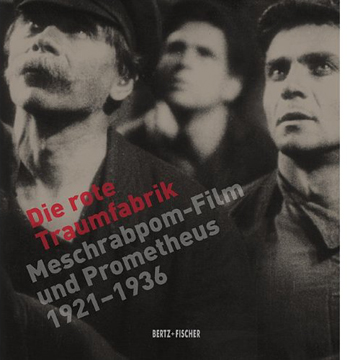 them, the re-equipment of studios with lighting equipment, cameras, and raw stock was made possible largely through imports from Germany. Once Eisenstein and other directors began making films, they were exported to Germany, where their theatrical success led to further circulation in France, the United Kingdom, the USA, and elsewhere.
them, the re-equipment of studios with lighting equipment, cameras, and raw stock was made possible largely through imports from Germany. Once Eisenstein and other directors began making films, they were exported to Germany, where their theatrical success led to further circulation in France, the United Kingdom, the USA, and elsewhere.
There was a direct link between Soviet and German socialist film production and distribution that is too little-known today. In 1921, Willi Münzenberg forms the Internationalen Arbeiterhilfe (the IAH, known in Russia as Meschrabpom), based in Berlin. In 1924, the organization founded a film studio in Moscow, Rus. A year later, a sister company, Prometheus, was formed in Berlin. Both produced films, and they cooperated in distributing each other’s output.
Meschrabpom-Russ produced many of the familair Soviet classics: early on, Polikuschka and Aelita, and later the films of Pudovkin (including Mother and The End of St. Petersburg) and Boris Barnet (including Miss Mend and House on Trubnoya). Prometheus produced films highly influenced by the Soviet exports, both in terms of style and subject matter. These included Leo Mittler and Albrech V. Blum’s Jenseits der Strasse, Phil Jutzi’s Mutter Krausens Fahrt ins Glück, and, mostly famously, Bertolt Brecht and Ernst Ottwald’s Kuhle Wampe oder wem gehört die Welt.
Prometheus, not surprisingly, disappeared in 1933. Meschrabpom-Russ continued until 1936.
A retrospective at the Internationale Filmfestspiele in Berlin in 2012 has occasioned a comprehensive, beautifully designed catalogue, Die rote Traumfabrik: Meschrabpom-Film und Promethueus 1921-1936. With numerous expert essays and beautifully reproduced illustrations, both in color and black and white, of posters, production photos, film frames, and documents, this is the definitive publication on the subject. Even those who don’t read German will be able to use the extensive filmography and the biographical entries on the directors and other people involved in the making of the films. The illustrations make this the perfect combination of academic study and coffee-table art book. (KT)
Closer to home, our friends have been very busy. From Leger Grindon, a deeply knowledgeable specialist in American film, comes Knockout: The Boxer and Boxing in American Cinema. The prizefight movie isn’t usually discussed as a distinct genre, but after reading this comprehensive and subtle study, you’ll likely be convinced that it’s been remarkably important. While discussing movies as famous as Raging Bull and as little-known as Iron Man (no, not that one; this one comes from 1931), Leger also introduces you to the finer points of genre criticism. The way he traces basic plot structures, key iconography, and historical patterns of change is a model of how thinking in genre terms can illuminate individual films.
Then there’s Tashlinesque: The Hollywood Comedies of Frank Tashlin. Ethan de Seife goes beyond the usual recounting of peculiar, often lewd gag moments to treat Tashlin as not only a gifted director but a representative figure in 1940s-1950s American cinema. Ethan traces how Tashlin became a program-picture director who never acquired the status of auteur, at least in the eyes of the studio system. The book situates Tashlin in the context of the Hollywood industry, both the cartoon shops (Tashlin did animation work for both Disney and Warners, among others) and the live-action production units. There’s as well a fascinating chapter on Tashlin’s influence on directors as different as Joe Dante and Jean-Luc Godard, who coined the adjective “Tashlinesque.” A blend of critical analysis, cultural commentary, and industry history, Tashlinesque is surely the definitive book on this cheerfully dirty-minded moviemaker. Ethan maintains a lively blog here.
Not strictly about cinema, but a book that’s indispensible for film researchers, is James Cortada’s History Hunting: A Guide for Fellow Adventurers. A founding member of the Irvington Way Institute, Jim is at once an IT guru, a historian of computer technology, and a scholar of Spanish history, particularly of the Civil War. History Hunting, the fruit of forty years of spelunking in archives, museums, and the world at large, is an enjoyable handbook on doing historical research. It ranges from help with genealogy (case study: the colorful Cortadas, from Spain to the US) to suggestions about how to frame a doctoral thesis. Jim reminds us that the historian must turn into an archivist: the materials you collect are documents for future historians to use. You are, to use the new buzzword, a curator. Jim provides a welter of practical suggestions along with his own tales of the hunt. Jim devotes part of a chapter to Kristin and me, which just goes to show his impeccable taste in neighbors.
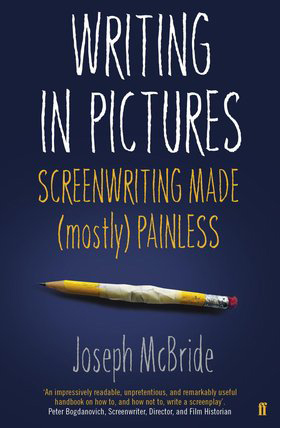 Joseph McBride is known as a film historian—his biographical books on Ford, Welles, and Spielberg are scrupulous and insightful—but he also teaches screenwriting. Why not? He wrote the cult classic Rock and Roll High School. Writing in Pictures: Screenwriting Made (Mostly) Painless is a unique manual in that it minimizes how-to instructions. Joe acknowledges the centrality of the three-act structure, but he takes a step back and asks what engages us about stories to begin with. His advice is clear-sighted. Don’t follow trends; don’t worry about “high-concept” ideas or “character arcs” or “plot points.” Closely study the masters of storytelling in fiction and drama and film, and absorb not formulas but a feeling for the flexibility of narrative technique.
Joseph McBride is known as a film historian—his biographical books on Ford, Welles, and Spielberg are scrupulous and insightful—but he also teaches screenwriting. Why not? He wrote the cult classic Rock and Roll High School. Writing in Pictures: Screenwriting Made (Mostly) Painless is a unique manual in that it minimizes how-to instructions. Joe acknowledges the centrality of the three-act structure, but he takes a step back and asks what engages us about stories to begin with. His advice is clear-sighted. Don’t follow trends; don’t worry about “high-concept” ideas or “character arcs” or “plot points.” Closely study the masters of storytelling in fiction and drama and film, and absorb not formulas but a feeling for the flexibility of narrative technique.
One of the most original aspects of Writing in Pictures is Joe’s emphasis on adaptation. This is sensible because (a) a great many films are adapted from other sources (today, even comic books); (b) a professional screenwriter is often called upon to reshape an earlier script draft by another writer; and (c) adapting a preexisting source swiftly gets the novice screenwriter thinking about the relative strengths of verbal and visual storytelling. Joe takes us through the script-building process step by step, each time reworking London’s story “To Build a Fire.” Somewhat like the European “conservatory” approach to film education, McBride’s emphasis on organic interaction with classic traditions is something new, even radical, in the world of American screenplay education.
Then there’s Film and Risk, edited by the boundlessly prolific and enthusiastic Mette Hjort. Probably the most conceptually bold cinema book of the year, it assembles several scholars and filmmakers to assess how films and filmmakers deal with risk. The subject is of course broad. There’s risk in performance; risk in breaking stylistic boundaries; risk within film institutions (such as producing); risk in social and political contexts such as facing censorship; environmental risks, as in the costs that filmmaking exacts from the natural world; and even the risks of viewing movies—exposing yourself to horrifying or depressing stories and images. Film scholars like Hjort, Paisley Livingston, and Jinhee Choi mingle with film producers and industry observers to reflect on how cinema takes chances.
Our colleague J. J. Murphy has been researching and teaching the films of Andy Warhol for years, and today–literally, today–his monograph The Black Hole of the Camera: The Films of Andy Warhol comes out from the University of California Press. This is the most comprehensive, in-depth study of Warhol’s filmmaking that has ever been published, and of course a must-have for anyone interested in experimental film or the American art scene.
The ideas are fresh, especially the explorations of Warhol’s debt to psychodrama. At the same time, The Black Hole of the Camera clears away many misconceptions about Warhol (no, Sleep and Empire are not single-shot films) while also offering detailed information about and analysis of little-known stunners like Outer and Inner Space. There are several pages of color frames, which remind you that Warhol was as good at color as Tashlin was. JJ maintains a remarkable blog on independent cinema and is a leading figure in the Screenwriting Research Network.
Not a book, but a publication of great value: Three major researchers have collaborated on a cogent, nontechnical review of experimental investigations into film perception. All of the authors have had face time on this site. Dan Levin has executed breakthrough experiments on “change blindness”–how we miss discontinuities and anomalies in everyday life. (On another dimension, Dan’s film Filthy Theatre is coming up at our Wisconsin Film Festival.) James Cutting, a venerable figure in visual perception research, has ranged across many key areas in his consideration of cinema. He also wrote a wonderful book, available free here, on Impressionist painting. And Tim Smith, virtuoso eye-tracker, is author of one of our all-time most popular blog entries, “Watching you watch There Will Be Blood.”
With three top talents, you’d expect the collaborative paper to be a triumph of synthesis, and so it is. It supplies the best case I know for why we cinephiles should welcome psychologists who test the ways we watch movies. It should be required reading in every film theory course in the land. Access to the published paper requires a purchase or a library subscription, but you can read the preprint version here. Check in at Tim’s blog Continuity Boy for plenty of videos exploring his research (DB).
Finally, we’re sometimes asked why we don’t allow comments on our blog. The simple answer is that we’re not nearly as good at responding to comments as John Cleese is.
The cover of Joe McBride’s book pictured above is from the Faber & Faber edition, which makes a better still than the US edition from Vintage. Same good stuff inside, though.












